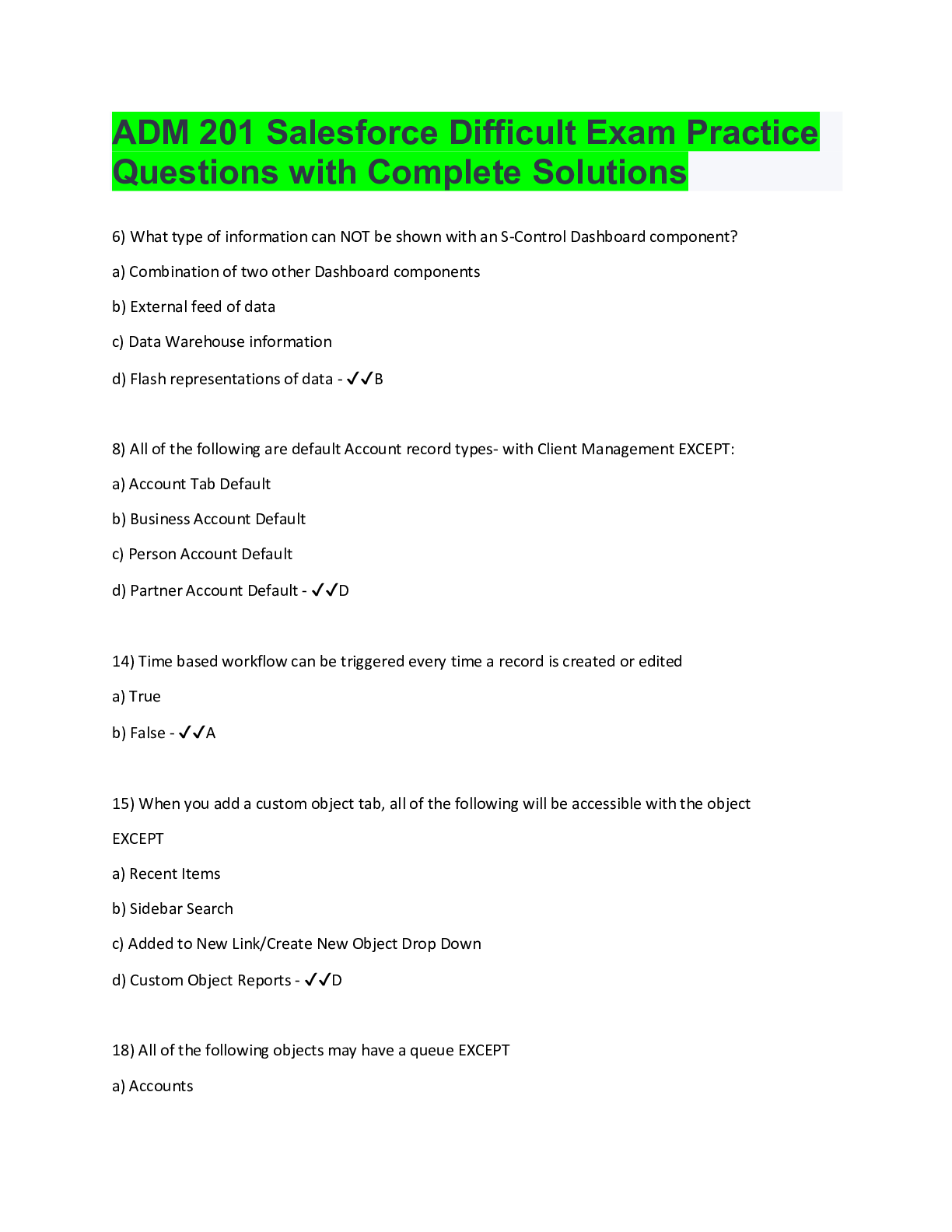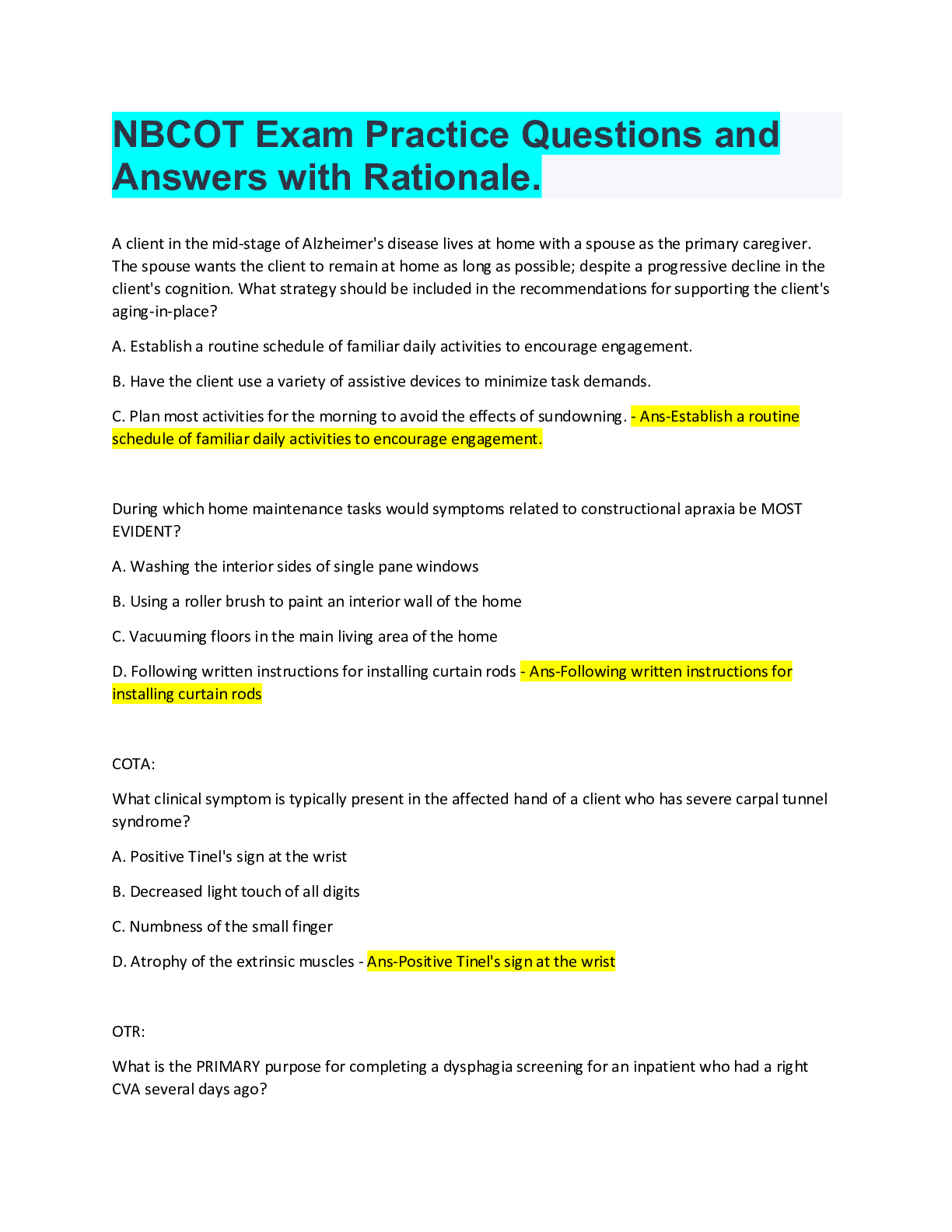*NURSING > QUESTIONS & ANSWERS > NURS 629 Exam Practice Questions and Answers (100% correct) (All)
NURS 629 Exam Practice Questions and Answers (100% correct)
Document Content and Description Below
NURS 629 Exam Practice Questions and Answers Questions 1. The primary care pediatric nurse practitioner performs a vision screen on a 4- ID: 13348411154 month-old infant and note... s the presence of convergence and accommodation with mild esotropia of the left eye. What will the nurse practitioner do? A. Patch the right eye to improve coordination of the left eye. B. Reassure the parents that the infant will outgrow this. C. Recheck the infant’s eyes in 2 to 4 weeks. D. Refer the infant to a pediatric ophthalmologist. Correct 2. During a well child exam on a 4-year-old child, the primary care pediatric nurse ID: 13348411168 practitioner notes that the clinic nurse recorded “20/50” for the child’s vision and noted that the child had difficulty cooperating with the exam. What will the nurse practitioner recommend? A. Follow up with a visual acuity screen in 6 months. B. Refer to a pediatric ophthalmologist. C. Re-test the child in 1 year. D. Test the child’s vision in 1 month. 3. During a well child assessment of an African-American infant, the primary care ID: 13348411148 pediatric nurse practitioner notes a dark red-brown light reflex in the left eye and a slightly brighter, red-orange light reflex in the right eye. The nurse practitioner will A. dilate the pupils and reassess the red reflex. B. order auto-refractor screening of the eyes. C. recheck the red reflex in 1 month. D. refer the infant to an ophthalmologist. Correct 4. The primary care pediatric nurse practitioner performs a Hirschberg test to evaluate A. color vision. B. ocular alignment. Correct C. peripheral vision. D. visual acuity. 5. The primary care pediatric nurse practitioner applies fluorescein stain to a child’s eye. When examining the eye with a cobalt blue filter light, the entire cornea appears cloudy. What does this indicate? A. The cornea has not been damaged. ID: 13348411150 ID: 13348411146 B. There is too little stain on the cornea. C. There is damage to the cornea. D. There is too much stain on the cornea. Correct 6. A toddler exhibits exotropia of the right eye during a cover-uncover screen. The ID: 13348411156 primary care pediatric nurse practitioner will refer to a pediatric ophthalmologist to initiate which treatment? A. Botulinum toxin injection B. Corrective lenses C. Occluding the affected eye for 6 hours per day D. Patching of the unaffected eye for 2 hours each day 7. The primary care pediatric nurse practitioner performs a well child examination on ID: 13348411140 a 9-month-old infant who has a history of prematurity at 28 weeks’ gestation. The infant was treated for retinopathy of prematurity (ROP) and all symptoms have resolved. When will the infant need an ophthalmologic exam? A. At 12 months of age Correct B. At 24 months of age C. At 48 months of age D. At 60 months of age 8. During a well-baby assessment on a 1-week-old infant who had a normal exam ID: 13348411144 when discharged from the newborn nursery 2 days prior, the primary care pediatric nurse practitioner notes moderate eyelid swelling, bulbar conjunctival injections, and moderate amounts of thick, purulent discharge. What is the likely diagnosis? A. Chemical-induced conjunctivitis B. Chlamydia trachomatis conjunctivitis Correct C. Herpes simplex virus (HSV) conjunctivitis D. Neisseria gonorrhea conjunctivitis 9. The primary care pediatric nurse practitioner performs a well baby assessment of ID: 13348411152 a 5-day-old infant and notes mild conjunctivitis, corneal opacity, and serosanguinous discharge in the right eye. Which course of action is correct? A. Administer intramuscular ceftriaxone 50 mg/kg. B. Admit the infant to the hospital immediately. Correct C. Give oral erythromycin 30 to 50 mg/kg/day for 2 weeks. D. Teach the parent how to perform tear duct massage. 10. A preschool-age child who attends day care has a 2-day history of matted eyelids K. L. ID: in the morning and burning and itching of the eyes. The primary care pediatric nurse practitioner notes yellow-green purulent discharge from both eyes, conjunctival erythema, and mild URI symptoms. Which action is correct? I. A. Culture the conjunctival discharge. B. Observe the child for several days. C. Order an oral antibiotic medication. D. Prescribe topical antibiotic drops. Correct 11. A 14-year-old child has a 2-week history of severe itching and tearing of both J. ID: eyes. The primary care pediatric nurse practitioner notes redness and swelling of the eyelids along with stringy, mucoid discharge. What will the nurse practitioner prescribe? G. A. Saline solution or artificial tears B. Topical mast cell stabilizer C. Topical NSAID drops D. Topical vasoconstrictor drops 12. The primary care pediatric nurse practitioner observes a tender, swollen red H. ID: furuncle on the upper lid margin of a child’s eye. What treatment will the nurse practitioner recommend? A. Culture of the lesion to determine causative organism B. Referral to ophthalmology for incision and drainage C. Topical steroid medication D. Warm, moist compresses 3 to 4 times daily 13. The primary care pediatric nurse practitioner is treating an infant with lacrimal duct E. F. ID: obstruction who has developed bacterial conjunctivitis. After 2 weeks of treatment with topical antibiotics along with massage and frequent cleansing of secretions, the infant’s symptoms have not improved. Which action is correct? A. Perform massage more frequently. B. Prescribe an oral antibiotic. C. Recommend hot compresses. D. Refer to an ophthalmologist. Correct 14. A preschool-age child is seen in the clinic after waking up a temperature of ID: 13348411158 102.2°F, swelling and erythema of the upper lid of one eye, and moderate pain when looking from side to side. Which course of treatment is correct? A. Admit to the hospital for intravenous antibiotics. Correct B. Obtain a lumbar puncture and blood culture. C. Order warm compresses 4 times daily for 5 days. D. Prescribe a 10- to 14-day course of oral antibiotics. 15. A school-age child is seen in the clinic after a fragment from a glass bottle flew into the eye. What will the primary care pediatric nurse practitioner do? A. Refer immediately to an ophthalmologist. Correct B. Attempt to visualize the glass fragment. C. Irrigate the eye with sterile saline. D. Instill a topical anesthetic. 16. A school-age child is hit in the face with a baseball bat and reports pain in one ID: 13348411164 ID: 13348411142 eye. The primary care pediatric nurse practitioner is able to see a dark red fluid level between the cornea and iris on gross examination, but the child resists any exam with a light. Which action is correct? A. Administer an oral analgesic medication. B. Apply a Fox shield and reevaluate the eye in 24 hours. C. Instill anesthetic eyedrops into the affected eye. D. Refer the child immediately to an ophthalmologist. Correct Questions 1. The parent of a 4-month-old infant is concerned that the infant cannot hear. ID: 13348431621 Which test will the primary care pediatric nurse practitioner order to evaluate potential hearing loss in this infant? A. Acoustic reflectometry B. Audiometry C. Auditory brainstem response (ABR) Correct D. Evoked otooacoustic emission (EOAE) testing 2. The primary care pediatric nurse practitioner obtains a tympanogram on a child that reveals a sharp peak of -180 mm H2O. What does this value indicate? A. A normal tympanic membrane B. Middle ear effusion C. Negative ear pressure Correct D. Tympanic membrane perforation 3. An 18-month-old child with no previous history of otitis media awoke during the night with right ear pain. The primary care pediatric nurse practitioner notes an axillary ID: 13348431629 ID: 13348431617 temperature of 100.5°F and an erythematous, bulging tympanic membrane. A tympanogram reveals of peak of +150 mm H2O. What is the recommended treatment for this child? A. Amoxicillin 80 to 90 mg/kg/day in two divided doses B. An analgesic medication and watchful waiting Correct C. Ceftriaxone 50 to 75 mg/kg/dose IM given once D. Ototopical antibiotic drops twice daily for 5 days 4. A 7-month-old infant has had two prior acute ear infections and is currently on the ID: 13348431609 10th day of therapy with amoxicillin-clavulanate after a failed course of amoxicillin. The primary care pediatric nurse practitioner notes marked middle ear effusion and erythema of the TM. The child is irritable and has a temperature of 99.8°F. What is the next step in management of this child’s ear infection? A. Order a second course of amoxicillin-clavulanate. B. Perform tympanocentesis for culture. C. Prescribe clindamycin twice daily. D. Refer the child to an otolaryngologist. Correct 5. A 3-year-old child with pressure-equalizing tubes (PET) in both ears has otalgia in ID: 13348431627 one ear. The primary care pediatric nurse practitioner is able to visualize the tube and does not see exudate in the ear canal and obtains a type A tympanogram. What will the nurse practitioner do? A. Order ototopical antibiotic/corticosteroid drops. B. Prescribe a prophylactic antibiotic medication. C. Reassure the parent that this is a normal exam. D. Refer the child to an otolaryngologist for follow-up 6. What will the primary care pediatric nurse practitioner teach the parents of a child who has new pressure-equalizing tubes (PET) in both ears? A. Parents should notice improved hearing in their child. B. PET will help by reducing the number of ear infections the child has. C. The child should use earplugs when showering or bathing. D. The tubes will most likely remain in place for 3 to 4 years. 7. A child with a history of otitis externa asks about ways to prevent this condition. What will the primary care pediatric nurse practitioner recommend? A. Cleaning ear canals well after swimming B. Drying the ear canal with a hair dryer Correct C. Swimming only in chlorinated pools D. Using cerumenolytic agents daily 8. A child complains of itching in both ears and is having trouble hearing. The ID: 13348431619 ID: 13348431623 ID: 13348431631 primary care pediatric nurse practitioner notes periauricular edema and marked swelling of the external auditory canal and elicits severe pain when manipulating the external ear structures. Which is an appropriate intervention? A. Obtain a culture of the external auditory canal. B. Order ototopical antibiotic/corticosteroid drops. Correct C. Prescribe oral amoxicillin-clavulanate. D. Refer the child to an otolaryngologist. 9. A child who has otitis externa has severe swelling of the external auditory canal ID: 13348431607 that persists after 2 days of therapy with ototopical antibiotic/corticosteroid drops. What is the next step in treatment for this child? A. Insert a wick into the external auditory canal. Correct B. Irrigate the external auditory canal with saline. C. Order systemic corticosteroids. D. Prescribe an oral antibiotic medication. J. 10. The primary care pediatric nurse practitioner notes a small, round object in a K. ID: child’s external auditory canal, near the tympanic membrane. The child’s parent thinks it is probably a dried pea. What will the nurse practitioner do to remove this object? A. Irrigate the external auditory canal to flush out the object. B. Refer the child to an otolaryngologist for removal. Correct C. Remove the object with a wire loop curette. D. Use a bayonet forceps to grasp and remove the object. 11. A 3-year-old child has had one episode of acute otitis media 3 weeks prior with a H. I. ID: normal tympanogram just after treatment with amoxicillin. In the clinic today, the child has a type B tympanogram, a temperature of 102.5°F, and a bulging tympanic membrane. What will the primary care pediatric nurse practitioner order? A. A referral for tympanocentesis B. Amoxicillin twice daily C. Amoxicillin-clavulanate twice daily Correct D. Intramuscular ceftriaxone 12. The primary care pediatric nurse practitioner diagnoses acute otitis media in a 2- F. G. ID: year-old child who has a history of three ear infections in the first 6 months of life. The child’s tympanic membrane is intact and the child has a temperature of 101.5°F. What will the nurse practitioner prescribe for this child? A. Amoxicillin twice daily for 10 days B. An analgesic medication and watchful waiting Correct C. Antibiotic ear drops and ibuprofen D. Ceftriaxone given once intramuscularly 13. A child who was treated with amoxicillin and then amoxicillin-clavulanate for acute D. E. ID: otitis media is seen for follow-up. The primary care pediatric nurse practitioner notes dull-gray tympanic membranes with a visible air-fluid level. The child is afebrile and without pain. What is the next course of action? A. Administering ceftriaxone IM B. Giving clindamycin orally C. Monitoring ear fluid levels for 3 months Correct D. Watchful waiting for 48 to 72 hours 14. A school-age child has a history of chronic otitis media and is seen in the clinic ID: 13348431611 with vertigo. The primary care pediatric nurse practitioner notes profuse purulent otorrhea from both pressure-equalizing tubes and a pearly-white lesion on one tympanic membrane. Which condition is most likely? A. Cholesteatoma Correct B. Mastoiditis C. Otitis externa D. Otitis media with effusion Questions 1. The primary care pediatric nurse practitioner is examining a 2-week-old infant and auscultates a wide splitting of S2 during expiration. What condition may this finding represent? A. Atrial septal defect Correct B. Coarctation of the aorta C. Patent ductus arteriosis D. Ventricular septal defect 2. The primary care pediatric nurse practitioner auscultates a new grade II vibratory, ID: 13348441121 ID: 13348441129 mid-systolic murmur at the mid sternal border in a 4-year-old child that is louder when the child is supine. What type of murmur is most likely? A. Pathologic murmur B. Pulmonary flow murmur C. Still’s murmur D. Venous hum 3. During a well child assessment, the primary care pediatric nurse practitioner ID: 13348441107 auscultates a harsh, blowing grade IV/VI murmur in a 6-month-old infant. What will the nurse practitioner do next? A. Get a complete blood count to rule out severe anemia. B. Obtain an electrocardiogram to assess for arrhythmia. C. Order a chest radiograph to evaluate for cardiomegaly. D. Refer to a pediatric cardiologist for further evaluation. Correct 4. The primary care pediatric nurse practitioner provides primary care for a 4-month- ID: 13348441105 old infant who has a ventricular septal defect. The infant has been breastfeeding well but in the past month has dropped from the 20th percentile to the 5th for weight. What will the nurse practitioner recommend? A. Adding solid foods to the infant’s diet to increase caloric intake B. Fortifying breast milk to increase the number of calories per ounce Correct C. Stopping breastfeeding and giving 30 kcal/ounce formula D. Supplementing breastfeeding with 24 kcal/ounce formula 5. A 12-month-old infant who had cardiopulmonary bypass with RBC and plasma ID: 13348441117 infusions during surgery at 8 months is seen for a well child examination. Which vaccine may be administered at this visit? A. MMR B. OPV C. PCV-13 D. Varivax 6. The primary care pediatric nurse practitioner performs a well child examination on ID: 13348437999 a 12-month-old child who had repair of a congenital heart defect at 8 months of age. The child has a normal exam. The parent reports that the child is not taking any medications. The nurse practitioner will contact the child’s cardiologist to discuss whether the child needs which medication? A. Amoxicillin Correct B. Capoten C. Digoxin D. Furosemide 7. During a well baby examination of a 6-week-old infant, the primary care pediatric ID: 13348437995 nurse practitioner notes poor weight gain, acrocyanosis of the hands and feet, and a respiratory rate of 60 breaths per minute. Oxygen saturation on room air is 93%. The remainder of the exam is unremarkable. Which action is correct? A. Follow-up in 1 week to assess the infant’s weight. B. Order a chest radiograph and an electrocardiogram. C. Reassure the parents that the exam is within normal limits. D. Refer the infant to a pediatric cardiologist. Correct 8. A 3-month-old infant who was previously healthy now has a persistent cough, ID: 13348441103 bilateral lung crackles, and poor appetite. The primary care pediatric nurse practitioner auscultates a grade III/VI, low-pitched, holosystolic murmur over the left lower sternal border and palpates the liver at one centimeter below the ribs. What diagnosis is likely? A. Atrial septal defect B. Coarctation of the aorta C. Patent ductus arteriosis D. Ventricular septal defect 9. An infant with trisomy 21 has a complete AV canal defect. Which finding, ID: 13348441101 associated with having both of these conditions, will the primary care pediatric nurse practitioner expect? A. Crackles in both lungs B. Hepatomegaly C. Oxygen desaturation Correct D. Peripheral edema 10. A 9-month-old infant has a grade III/VI, harsh, rumbling, continuous murmur in the ID: 13348441131 left infraclavicular fossa and pulmonic area. A chest radiograph reveals cardiac enlargement. The primary care pediatric nurse practitioner will refer the infant to a pediatric cardiologist and prepare the parents for which intervention to repair this defect? A. Cardiopulmonary bypass surgery B. Coil insertion in the catheterization laboratory Correct C. Indomethacin administration D. Observation for spontaneous closure 11. A 5-year-old child who had a repair for transposition of the great arteries shortly ID: 13348437991 after birth is growing normally and has been asymptomatic since the surgery. The primary care nurse practitioner notes mild shortness of breath with exertion and, upon questioning, learns that the child has recently complained of dizziness. What will the nurse practitioner do? A. Order an echocardiogram and chest radiograph. B. Perform pulmonary function testing. C. Reassure the parent that these symptoms are common. D. Refer the child to the cardiologist immediately. Correct 12. The primary care pediatric nurse practitioner is performing a well child ID: 13348437997 examination on a school-age child who had complete repair of a tetralogy of Fallot defect in infancy. What is important in this child’s health maintenance regime? A. Cardiology clearance for sports participation Correct B. Restriction of physical activity to avoid pulmonary complications C. Sub-acute bacterial endocarditis prophylaxis precautions D. Teaching about management of hypercyanotic episodes 13. The primary care pediatric nurse practitioner is performing a sports physical on an adolescent whose history reveals mild aortic stenosis. What will the nurse practitioner recommend? A. Avoidance of all sports to prevent sudden death B. Clearance for any sports since this is mild C. Evaluation by a cardiologist prior to participation Correct D. Low-intensity sports, such as golf or bowling ID: 13348441119 14. During a routine well child exam on a 5-year-old child, the primary care pediatric ID: 13348441113 nurse practitioner auscultates a grade II/VI, harsh, late systolic ejection murmur at the upper left sternal border that transmits to both lung fields. The child has normal growth and development. What will the nurse practitioner suspect? A. Aortic stenosis B. Patent ductus arteriosus C. Pulmonic stenosis Correct D. Tricuspid atresia 15. A 5-year-old child has an elevated blood pressure during a well child exam. The ID: 13348441123 primary care pediatric nurse practitioner notes mottling and pallor of the child’s feet and lower legs and auscultates a systolic ejection murmur in the left infraclavicular region radiating to the child’s back. The nurse practitioner will suspect which condition? A. Aortic stenosis B. Coarctation of the aorta Correct C. Patent ductus arteriosus D. Pulmonic stenosis 16. An adolescent female has a history of repaired tetralogy of Fallot. Which long- term complication is a concern for this patient? A. Aortic stenosis B. Chronic cyanosis C. Mitral valve prolapse Correct D. Ventricular failure 17. A 6-year-old child has a systolic blood pressure between the 95th and 99th ID: 13348441127 ID: 13348441109 percentile for age, sex, and height and a diastolic blood pressure between the 90th and the 95th percentile on three separate clinic visits. This child’s blood pressure is classified as A. normotensive. B. pre-hypertensive. C. stage 1 hypertensive. Correct D. stage 2 hypertensive. 18. A 12-year-old child whose weight and BMI are in the 75th percentile has a ID: 13348437993 diastolic blood pressure that is between the 95th and 99th percentiles for age, sex, and height on three separate occasions. Initial tests for this child will include A. complete blood count. B. erythrocyte sedimentation rate. C. renal function and plasma renin tests. Correct D. urinalysis and electrolytes. 19. A 12-year-old child whose BMI is greater than the 95th percentile has a blood ID: 13348441115 pressure at the 98th percentile for age, sex, and height. After lifestyle changes that include diet and exercise, the child’s BMI drops to the 90th percentile, but the blood pressure remains the same. What is the primary care pediatric nurse practitioner’s next step in treating this child? A. Continued close monitoring of blood pressure B. Ordering an echocardiogram or MRI C. Prescribing an ACE inhibitor medication D. Referral to a nephrologist or cardiologist Correct 20. A 7-year-old child who has a history of a repaired congenital heart defect has ID: 13348441125 many dental caries along with gingival erythema and irritation and a temperature of 102.5°F. What will the primary care pediatric nurse practitioner do next? A. Admit to the hospital with a pediatric cardiology consult. Correct B. Obtain blood cultures and a CBC and consult a pediatric cardiologist. C. Refer the child to a pediatric dental surgeon immediately. D. Start prophylactic antibiotics such as penicillin twice daily for 2 weeks. 21. A 15-year-old female reports fainting at school in class on two occasions. The ID: 13348441111 adolescent’s orthostatic blood pressures are normal. The primary care pediatric nurse practitioner suspects a cardiac cause for these episodes and will order which tests before referring her to a pediatric cardiologist? A. 12-lead electrocardiogram Correct B. Echocardiogram C. Tilt table testing D. Treadmill exercise testing Questions 1. In a respiratory disorder causing a check-valve obstruction, which symptoms will be present? A. Air entry on inspiration with expiratory occlusion Correct B. Complete obstruction on inspiration and expiration C. Narrowing of the lumen with increased air flow resistance D. Obstruction of air entry with unimpeded expiratory air flow 2. A child has an acute infection causing lower airway obstruction. Which initial symptom is expected in this child? A. Atelectasis B. Barrel chest C. Over-inflation D. Wheezing Correct 3. A 4-year-old child with an upper respiratory tract infection has cloudy nasal ID: 13347936696 ID: 13348407620 ID: 13348407606 discharge and moderate nasal congestion interfering with sleep. The parent asks what product to use to help with symptoms. What will the primary care pediatric nurse practitioner recommend? A. Antihistamines B. Decongestant sprays C. Saline rinses Correct D. Zinc supplements 4. A 5-year-old child has enlarged tonsils and a history of four throat infections in the ID: 13348407610 previous year with fever, cervical lymphadenopathy, and positive Group AStreptococcus pyogenes (GABHS) cultures. The parent reports that the child snores at night and expresses concerns about the child’s quality of sleep. The next step in managing this child’s condition is to A. continue to observe the child for two or more GABHS infections. B. prescribe prophylactic antibiotics to prevent recurrent infection. C. refer to a pulmonologist for polysomnography evaluation. Correct D. refer to an otolaryngologist for possible tonsillectomy. 5. A school-age child has an abrupt onset of sore throat, nausea, headache, and a ID: 13348407618 temperature of 102.3°F. An examination reveals petechiae on the soft palate, beefy-red tonsils with yellow exudate, and a scarlatiniform rash. A Rapid Antigen Detection Test (RADT) is negative. What is the next step in management for this child? A. Consider a sexual abuse diagnosis. B. Obtain an anti-streptococcal antibody titer. C. Perform a follow-up throat culture. Correct D. Prescribe amoxicillin for 10 days. 6. An adolescent has suspected infectious mononucleosis after exposure to the ID: 13348407604 virus in the past week. The primary care pediatric nurse practitioner examines the adolescent and notes exudate on the tonsils, soft palate petechiae, and diffuse adenopathy. Which test will the primary care pediatric nurse practitioner perform to confirm the diagnosis? A. Complete blood count B. EBV-specific antibody testing C. Heterophile antibody testing D. Throat culture 7. A school-age child has had nasal discharge and daytime cough but no fever for ID: 13348407622 12 days without improvement in symptoms. The child has not had antibiotics recently and there is no significant antibiotic resistance in the local community. What is the appropriate treatment for this child? A. Amoxicillin 45 mg/kg/day Correct B. Amoxicillin 80-90 mg/kg/day C. Amoxicillin-clavulanate 80-90 mg/kg/day D. Saline irrigation for symptomatic relief 8. After 14 days of treatment with amoxicillin 45 mg/kg/day for acute rhinosinusitis, a ID: 13348407602 child continues to have mucopurulent nasal discharge along with induration, swelling, and erythema of both eyelids. What is the next course of treatment? A. Amoxicillin 80 mg/kg/day for 14 days B. Amoxicillin-clavulanate for 10 to 14 days C. Antibiotic ophthalmic drops for 5 to 7 days D. Referral to a pediatric otolaryngologist Correct 9. The parent of a toddler and a 4-week-old infant tells the primary care pediatric ID: 13348407616 nurse practitioner that the toddler has just been diagnosed with pertussis. What will the nurse practitioner do to prevent disease transmission to the infant? A. Administer the initial diphtheria, pertussis, and tetanus vaccine. B. Instruct the parent to limit contact between the toddler and the infant. C. Order azithromycin 10 mg/kg/day in a single dose daily for 5 days. Correct D. Prescribe erythromycin 10 mg/kg/dose four times daily for 14 days. J. 10. A school-age child has frequent nosebleeds. Nasal visualization reveals fresh K. ID: clots and excoriated nasal mucosa but no visible site of bleeding. Coagulation studies are normal. In spite of symptomatic measures, the child continues to have nosebleeds. What is the next course of action? H. A. Cauterize the mucosa with silver nitrate sticks. B. Order a topical vasoconstrictor medication. C. Prescribe a barrier agent such as petrolatum jelly. D. Refer to an otolaryngologist for further evaluation. Correct 11. A child is in the clinic because of symptoms of purulent, foul-smelling nasal I. ID: discharge from the right nostril. Nasal visualization reveals something shiny in a mass of mucous in the nasal cavity. What will the primary care pediatric nurse practitioner do? F. A. Attempt to remove the mass gently using alligator forceps. Correct B. Perform a saline nasal rinse using a water jet device. C. Refer the child to a pediatric otolaryngologist. D. Suction the mucoid mass using a bulb syringe. 12. A 2-year-old child is brought to the clinic after developing a hoarse, bark-like G. ID: cough during the night with “trouble catching his breath” according to the parent. The history reveals a 2 day history of low-grade fever and upper respiratory symptoms. On exam, the child has a respiratory rate of 40 breaths per minute, occasional stridor when crying, and a temperature of 101.3°F. What is the next step in treatment for this child? A. Administer intramuscular dexamethasone. B. Admit the child for inpatient hospitalization. C. Give the child a racemic epinephrine treatment in the office. D. Prescribe oral dexamethasone for 2 days. Correct 13. The primary care pediatric nurse practitioner evaluates a child who awoke with a D. E. ID: sore throat and high fever after a nap. The child appears anxious and is sitting on the parent’s lap with the neck hyperextended. The physical exam reveals stridor, drooling, nasal flaring, and retractions. What will the nurse practitioner do next? A. Administer a broad-spectrum intravenous antibiotic. B. Obtain blood and throat cultures and start antibiotic therapy. C. Send the child to radiology for a lateral neck radiograph. D. Transport the child to the hospital via emergency medical services. 14. A 5-month-old infant who has a 3-day history of cough and rhinorrhea has ID: 13348407612 developed symptoms of respiratory distress with audible expiratory wheezes and increased coughing. The infant’s immunizations are up-to-date. The physical exam reveals a respiratory rate of 50 breaths per minute, coarse expiratory wheezing, and prolonged expiration. An oxygen saturation is 96% on room air. What is the recommended treatment for this infant? A. Administer a trial of bronchodilators. B. Obtain a viral culture of nasal washings. C. Order an oral corticosteroid medication. D. Recommend increased fluids and close follow-up. Correct 15. A previously healthy school-age child develops a cough and a low-grade fever. ID: 13347936698 The primary care pediatric nurse practitioner auscultates wheezes in all lung fields. Which diagnosis will the nurse practitioner suspect? A. Atypical pneumonia Correct B. Bacterial pneumonia C. Bronchiolitis D. Bronchitis 16. A child is diagnosed with community-acquired pneumonia and will be treated as ID: 13348407600 an outpatient. Which antibiotic will the primary care pediatric nurse practitioner prescribe? A. Amoxicillin Correct B. Azithromycin C. Ceftriaxone D. Oseltamivir 17. The primary care pediatric nurse practitioner manages care in conjunction with a ID: 13348407624 pediatric pulmonologist for a child with cystic fibrosis. Which medication regimen is used to facilitate airway clearance for this child? A. Ibuprofen and azithromycin B. Inhaled dornase alfa Correct C. Ivacaftor D. Prophylactic clindamycin Questions 1. The primary care pediatric nurse practitioner is teaching a parent of a child ID: 13348425734 with dry skin about hydrating the skin with bathing. What will the nurse practitioner include in teaching? A. Apply lubricating agents at least 1 hour after the bath. B. Have the child soak in a lukewarm water bath. Correct C. Keep the child in the bath until the skin begins to “prune.” D. Soaping should be done at the beginning of the bath. 2. A child will need an occlusive dressing to treat lichen simplex chronicus. What ID: 13348425748 will the primary care pediatric nurse practitioner tell the parents about applying this treatment? A. Apply ointment before the dressing. Correct B. Plastic wrap should not be used. C. The dressing should be applied to dry skin. D. Change the dressing twice daily. 3. When prescribing topical glucocorticoids to treat inflammatory skin conditions, the primary care pediatric nurse practitioner will A. initiate therapy with a high-potency glucocorticoid. B. order lotions when higher potency is necessary. C. prescribe brand-name preparations for consistent effects. orrect D. use fluorinated steroids to minimize adverse effects. 4. A pre-school age child has honey-crusted lesions on erythematous, eroded ID: 13348425744 ID: 13348425732 skin around the nose and mouth, with satellite lesions on the arms and legs. The child’s parent has several similar lesions and reports that other children in the day care have a similar rash. How will this be treated? A. Amoxicillin 40 to 5 mg/kg/day for 7 to 10 days B. Amoxicillin-clavulanate 90 mg/kg/day for 10 days Correct C. Bacitracin cream applied to lesions for 10 to 14 days D. Mupirocin ointment applied to lesions until clear 5. A child is brought to clinic with several bright red lesions on the buttocks. The ID: 13348425726 primary care pediatric nurse practitioner examines the lesions and notes sharp margins and an “orange peel” look and feel. The child is afebrile and does not appear toxic. What is the course of treatment for these lesions? A. Hospitalize the child for intravenous antibiotics and possible I&D of the lesions. B. Initiate empiric antibiotic therapy and follow up in 24 hours to assess response. Correct C. Obtain blood cultures prior to beginning antibiotic treatment. D. Perform gram stain and culture of the lesions before initiating antibiotics. 6. An adolescent who recently spent time in a hot tub while on vacation has ID: 13348425742 discrete, erythematous 1- to 2-mm papules that are centered around hair follicles on the thighs, upper arms, and buttocks. How will the primary care pediatric nurse practitioner manage this condition? A. Culture the lesions and treat with appropriate IM antibiotics. B. Hospitalize for incision and drainage and intravenous antibiotics. C. Order an antistaphylococcal beta-lactamase-resistant antibiotic. D. Prescribe topical keratolytics and topical antibiotics. Correct 7. An infant is brought to clinic with bright erythema in the neck and flexural ID: 13348425710 folds after recent treatment with antibiotics for otitis media. What is the treatment for this condition? A. 1% hydrocortisone cream to affected areas for 1 to 2 days B. Oral fluconazole 6 mg/kg on day 1, then 3 mg/kg/dose for 14 days C. Topical keratolytics and topical antibiotics for 7 to 10 days D. Topical nystatin cream applied several times daily 8. A school-age child has several annular lesions on the abdomen ID: 13348425724 characterized by central clearing with scaly, red borders. What is the first step in managing this condition? A. Fluoresce the lesions with a Wood’s lamp. B. Obtain fungal cultures of the lesions. C. Perform KOH-treated scrapings of the lesion borders. D. Treat empirically with antifungal cream. 9. A child has several circular, scaly lesions on the arms and abdomen, some of ID: 13348425746 which have central clearing. The primary care pediatric nurse practitioner notes a smaller, scaly lesion on the child’s scalp. How will the nurse practitioner treat this child? A. Obtain scrapings of the lesions for fungal cultures. B. Order prescription-strength antifungal creams. C. Prescribe oral griseofulvin for 2 to 4 weeks. Correct D. Recommend OTC antifungal creams and shampoos. 10. A child is diagnosed with tinea versicolor. What is the correct management of ID: 13348425718 this disorder? A. Application of selenium sulfide 2.5% lotion twice weekly for 2 to 4 weeks Correct B. Oral antifungal treatment with fluconazole once weekly for 2 to 3 weeks C. Sun exposure for up to an hour every day for 2 to 4 weeks D. Using ketoconazole 2% shampoo on lesions twice daily for 2 to 4 weeks G. 11. An adolescent female has grouped vesicles on her oral mucosa. To H. ID: determine whether these are caused by HSV-1 or HSV-2, the primary care pediatric nurse practitioner will order which test? E. A. Direct fluorescent antibody test B. Enzyme-linked immunosorbent assay C. Tzanck smear D. Viral culture 12. A 4-year-old child has clusters of small, clear, tense vesicles with an F. ID: erythematous base on one side of the mouth along the vermillion border, which are causing discomfort and difficulty eating. What will the primary care pediatric nurse practitioner recommend as treatment? C. A. Mupirocin ointment applied to lesions 3 times daily B. Oral acyclovir 20 to 40 mg/kg/dose for 7 to 10 days C. Topical acyclovir applied to lesions 4 times daily D. Topical diphenhydramine and magnesium hydroxide 13. A previously healthy school-age child develops herpes zoster on the lower D. ID: back. What will the primary care pediatric nurse practitioner do to manage this condition? A. Order Burow solution and warm soothing baths as comfort measures. Correct B. Prescribe oral acyclovir 30 mg/kg/day in 4 doses/day for 5 days. C. Recommend topical antihistamines to control itching. D. Stress the need to remain home from school until the lesions are gone. 14. A child has small, firm, flesh-colored papules in both axillae which are mildly ID: 13348425752 pruritic. What is an acceptable initial approach to managing this condition? A. Application of trichloroacetic acid 25% to 50% using a dropper B. Applying liquid nitrogen for 2 to 3 seconds to each lesion C. Reassuring the parents that these are benign and may disappear spontaneously Correct D. Referral to a dermatologist for manual removal of lesions with curettage 15. A school-age child is brought to clinic after a pediculosis capitis infestation is ID: 13348425760 reported at the child’s school. If this child is positive, what will the primary care pediatric nurse practitioner expect to find on physical examination, along with live lice near the scalp? A. Excoriated macules along the child’s collar and underwear lines B. Inflammation and pustules on the face and neck C. Itching of the scalp, with skin excoriation on the back of the head Correct D. Linear or S-shaped lesions in webs of fingers and sides of hands 16. A 3-year-old child has head lice. What will the initial treatment recommendation be to treat this child? A. Lindane B. Permethrin Correct C. Pyrethrin D. Spinosad 17. A 9-month-old infant has vesiculopustular lesions on the palms and soles, on ID: 13348425706 ID: 13348425736 the face and neck, and in skin folds of the extremities. The primary care pediatric nurse practitioner notes linear and S-shaped burrow lesions on the parent’s hands and wrists. What is the treatment for this rash for this infant? A. Ivermectin 200 mcg/kg for 7 to 14 days, along with symptomatic treatment for itching B. Permethrin 5% cream applied to face, neck, and body and rinsed off in 8 to 14 hours Correct C. Treatment of all family members except the infant with permethrin 5% cream and ivermectin D. Treatment with permethrin 5% cream for 7 days in conjunction with ivermectin 200 mcg/kg 18. An adolescent has acne with lesions on the cheeks and under the chin. ID: 13348425708 Which distribution is this? A. Athletic B. Frictional C. Hormonal Correct D. Pomadal 19. An adolescent has acne characterized by papules and pustules mostly on the ID: 13348425714 forehead and chin. What will the primary care pediatric nurse practitioner prescribe? A. Azelaic acid applied daily at nighttime B. Benzoyl peroxide applied twice daily C. Topical erythromycin with benzoyl peroxide rrect D. Tretinoin applied nightly after washing the face 20. A child has an area of inflammation on the neck that began after wearing a ID: 13348425756 hand-knot woolen sweater. On examination, the skin appears chafed with mild erythematous patches. The lesions are not pruritic. What is an appropriate initial treatment? A. Application of a lanolin-based emollient B. Burow solution soaks and cool compresses C. Oral antihistamines given 4 times daily D. Topical corticosteroids applied 2 to 3 times daily 21. An adolescent who had cradle cap as an infant is in the clinic with thick crusts ID: 13348425758 of yellow, greasy scales on the forehead and behind the ears. What will the primary care pediatric nurse practitioner recommend? A. Daily application of ketoconazole 2% topical cream Correct B. High-potency topical corticosteroids applied daily C. Mineral oil and shampoo on the affected areas D. Selenium sulfide shampoo twice weekly to the face 22. A child is brought to the clinic with a generalized, annular rash characterized ID: 13348425754 by raised wheals with pale centers. On physical examination, the child’s lungs are clear and there is no peripheral edema. A history reveals ingestion of strawberries earlier in the day. What is the initial treatment? A. Aqueous epinephrine 1:1000 subcutaneously B. Cetirizine once in clinic and then once daily for 2 weeks C. Diphenhydramine 0.5 to 1 mg/kg/dose every 4 to 6 hours Correct D. Prednisone 1 to 2 mg/kg/day for 1 week with rapid taper 23. A child who has been taking antibiotics is brought to the clinic with a rash. ID: 13348425712 The parent reports that the child had a fever associated with what looked like sunburn and now has “blisters” all over. A physical examination shows coalescent target lesions and widespread bullae and areas of peeled skin revealing moist, red surfaces. What will the primary care pediatric nurse practitioner do? A. Consult with a pediatric intensivist for admission to a pediatric intensive care unit. Correct B. Order oral acyclovir 20 mg/kg/day in two doses for 6 to 12 months. C. Prescribe systemic antihistamines and antimicrobial medications as prophylaxis. D. Recommend analgesics, cool compresses, and oral antihistamines for comfort. 24. A school-age child has a rash without fever or preceding symptoms. Physical ID: 13348425740 examination reveals a 3-cm ovoid, erythematous lesion on the trunk with a finely scaled elevated border, along with generalized macular, ovoid lesions appearing in a “Christmas tree” pattern on the child’s back. What is the initial action? A. Obtain a KOH preparation of a skin scraping to verify the diagnosis. B. Prescribe topical steroid creams to shorten the course of the disease. C. Reassure the child’s parents that the rash is benign and self-limited. D. Recommend topical antihistamines and emollients to control the spread. 25. A child who has psoriasis, who has been using a moderate-potency topical ID: 13348425728 steroid on thick plaques on the extremities and a high-potency topical steroid on more severe plaques on the elbows and knees, continues to have worsening of plaques. In consultation with a dermatologist, which treatment will be added? A. Anthralin ointment in high strength applied for 10 to 30 minutes daily B. Calcipotriol cream applied liberally each day to the entire body C. Oral steroids and methotrexate therapy until plaques resolve D. Wideband ultraviolet therapy for 15 minutes twice daily 26. During a well child examination of an infant, the primary care pediatric nurse Correct ID: 13348425716 practitioner notes 10 café au lait spots on the infant’s trunk. What is the potential concern associated with this finding? A. Endocrine disorders B. Malignancy C. Neurofibromatosis Correct D. Sturge-Weber syndrome 27. The primary care pediatric nurse practitioner notes velvety, brown thickening ID: 13348425730 of skin in the axillae, groin, and neck folds of an adolescent Hispanic female who is overweight. What is the initial step in managing this condition? A. Consultation with a pediatric dermatologist B. Performing metabolic laboratory tests Correct C. Prescribing topical retinoic acid cream D. Referral to a pediatric endocrinologist 28. An African-American child has recurrent tinea capitis and has just developed ID: 13348425720 a new area of alopecia after successful treatment several months prior. When prescribing treatment with griseofulvin and selenium shampoo, what else will the primary care pediatric nurse practitioner do? A. Monitor CBC, LFT, and renal function during therapy. B. Order oral prednisone daily for 5 to 14 days. C. Perform fungal cultures on family members and pets. Correct D. Prescribe oral itraconazole or terbinafine. [Show More]
Last updated: 1 year ago
Preview 1 out of 25 pages
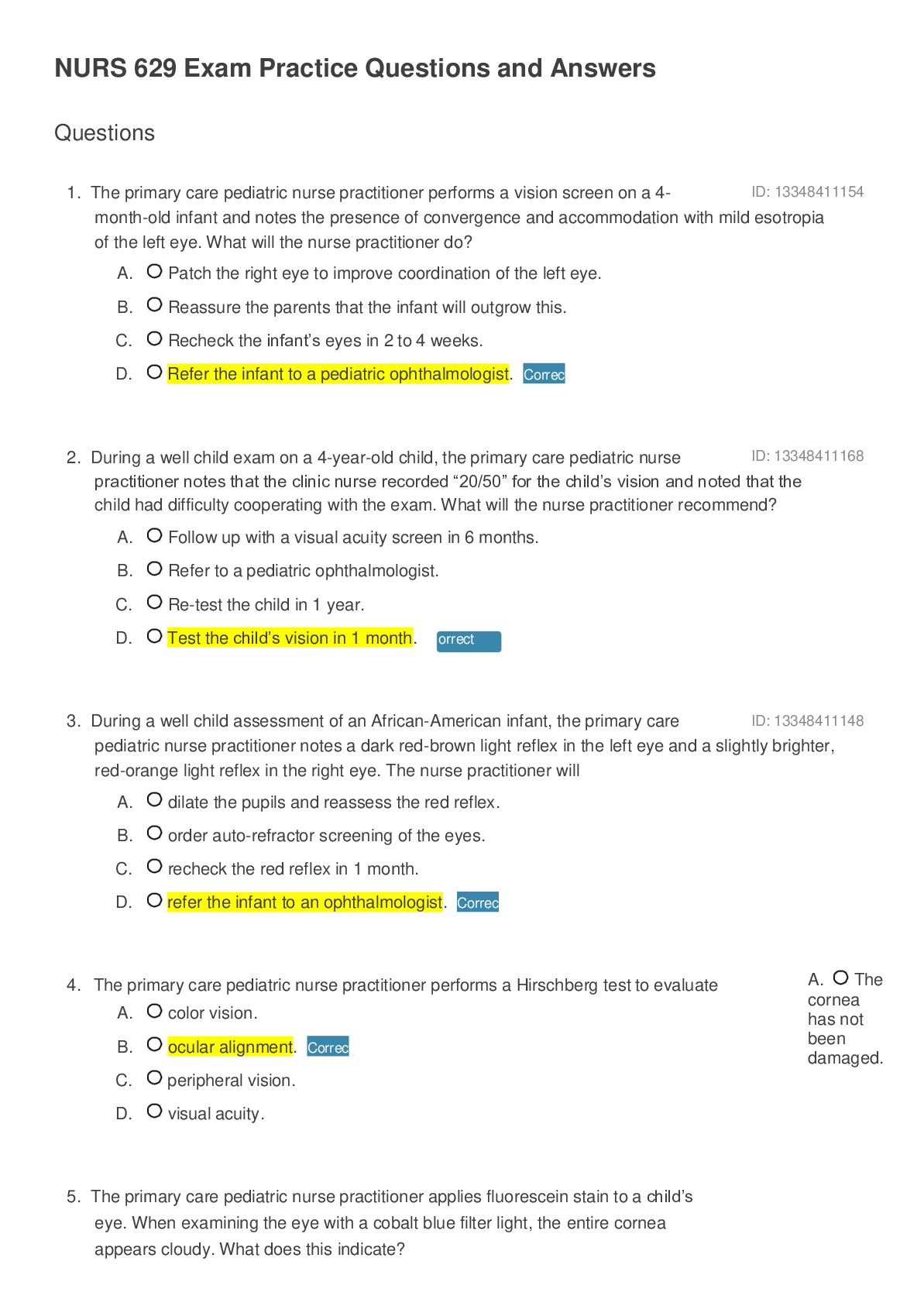
Reviews( 0 )
Document information
Connected school, study & course
About the document
Uploaded On
Jun 23, 2022
Number of pages
25
Written in
Additional information
This document has been written for:
Uploaded
Jun 23, 2022
Downloads
0
Views
106


 And LETRS Unit 8 Final Assessment Test.png)
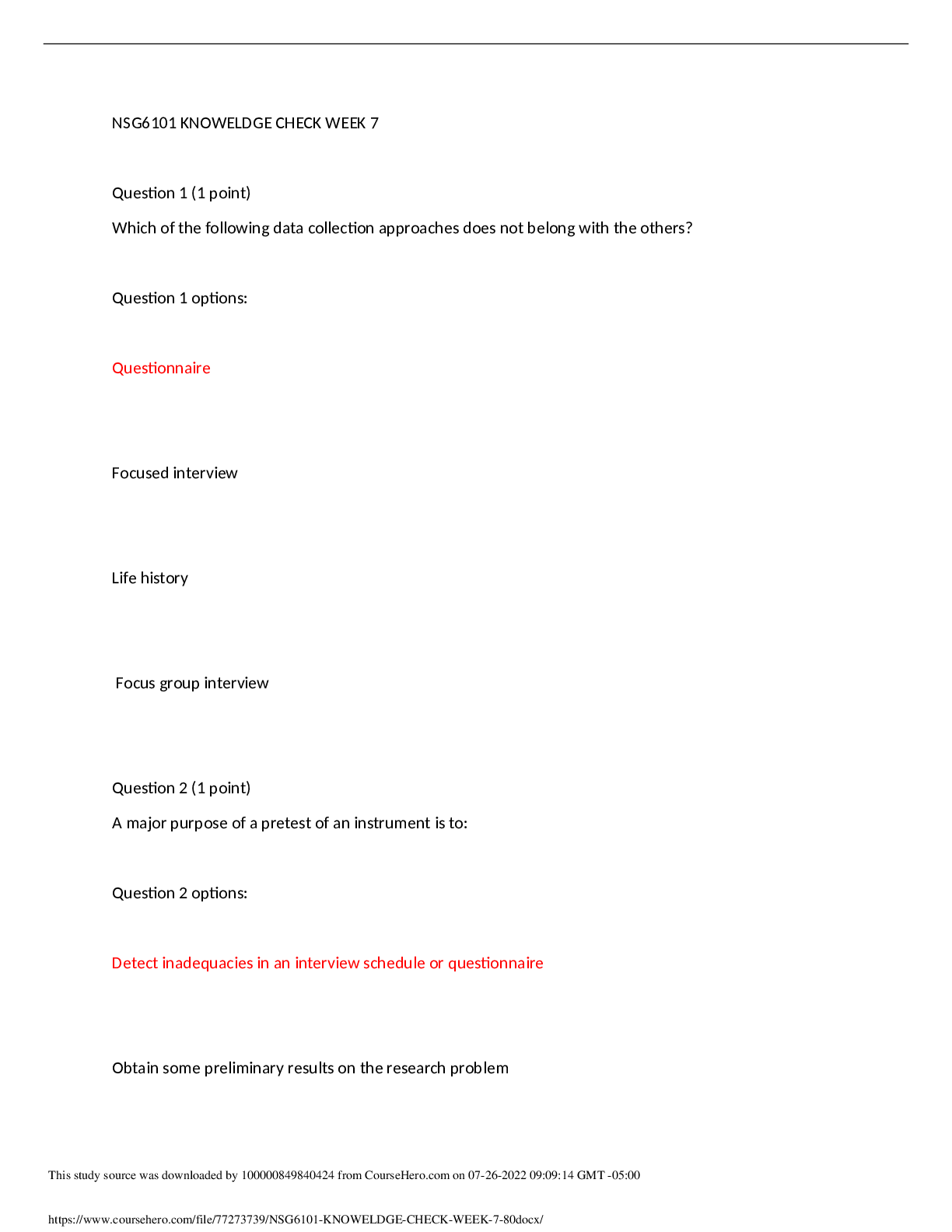
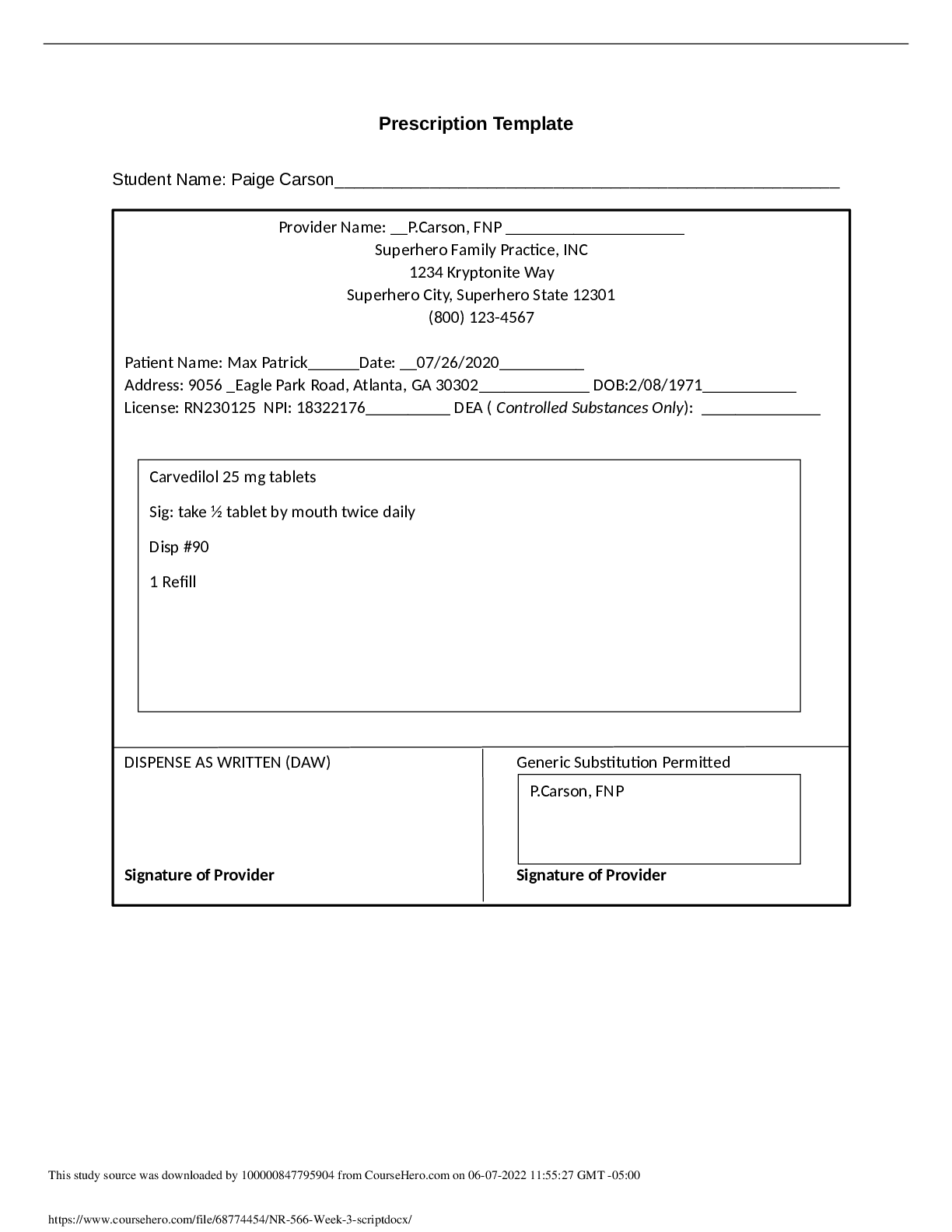
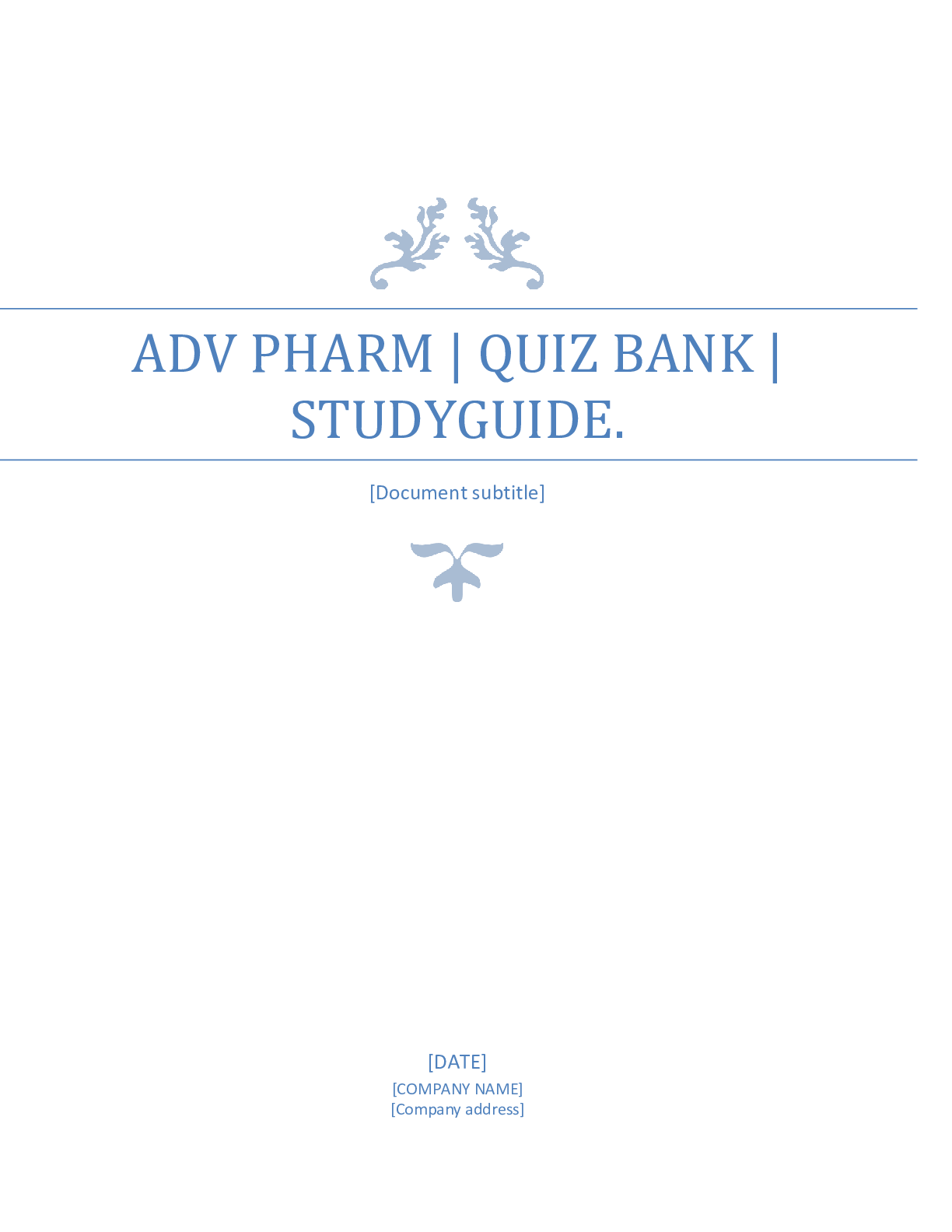

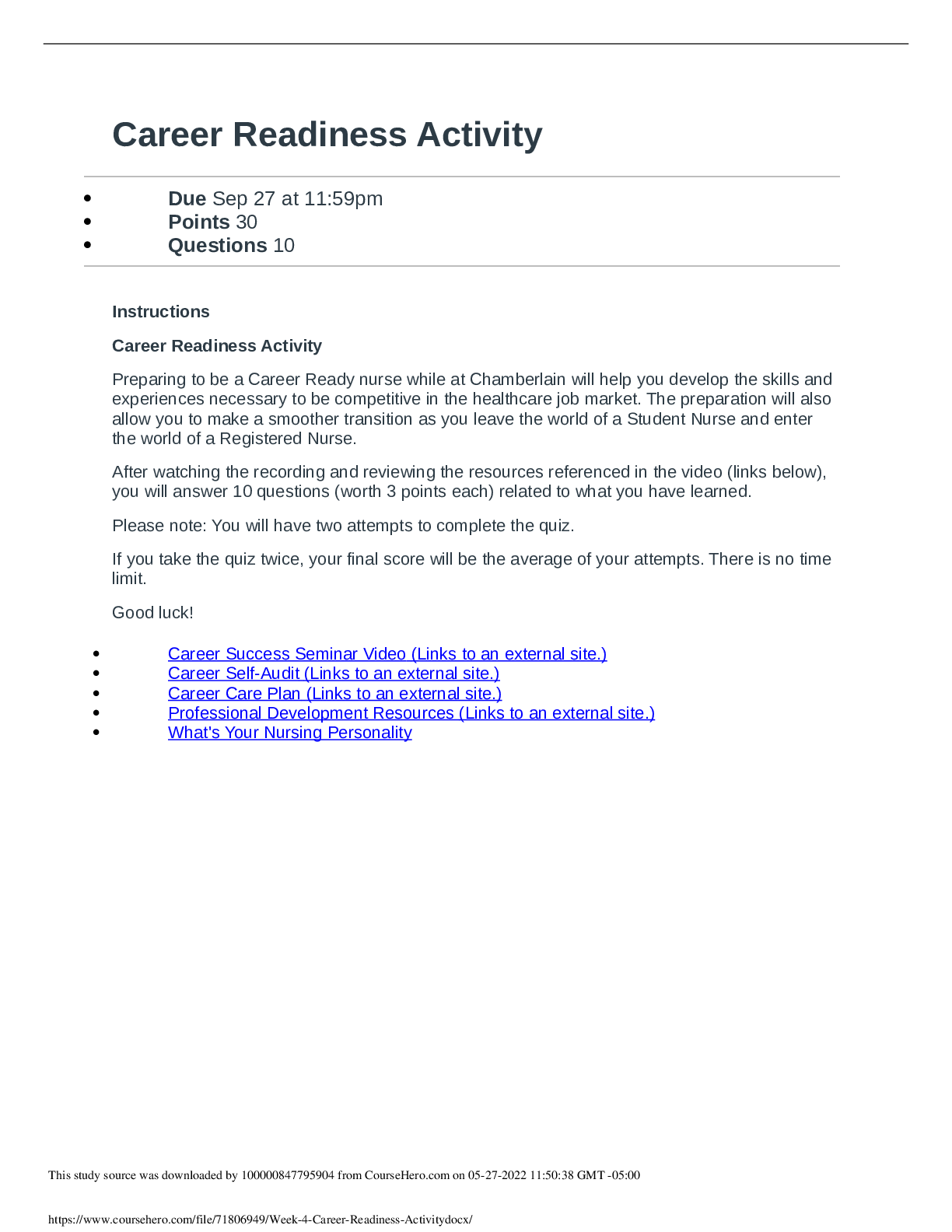
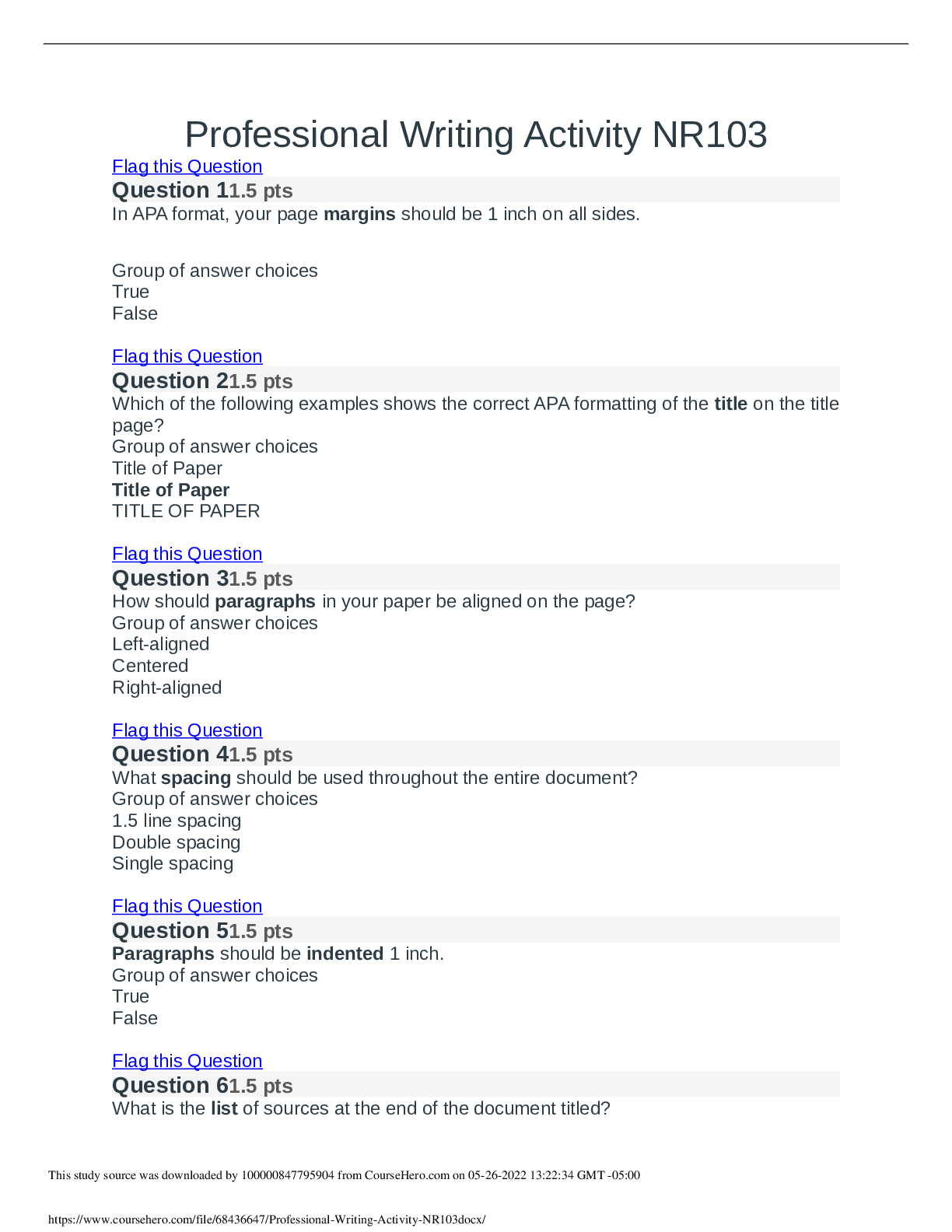
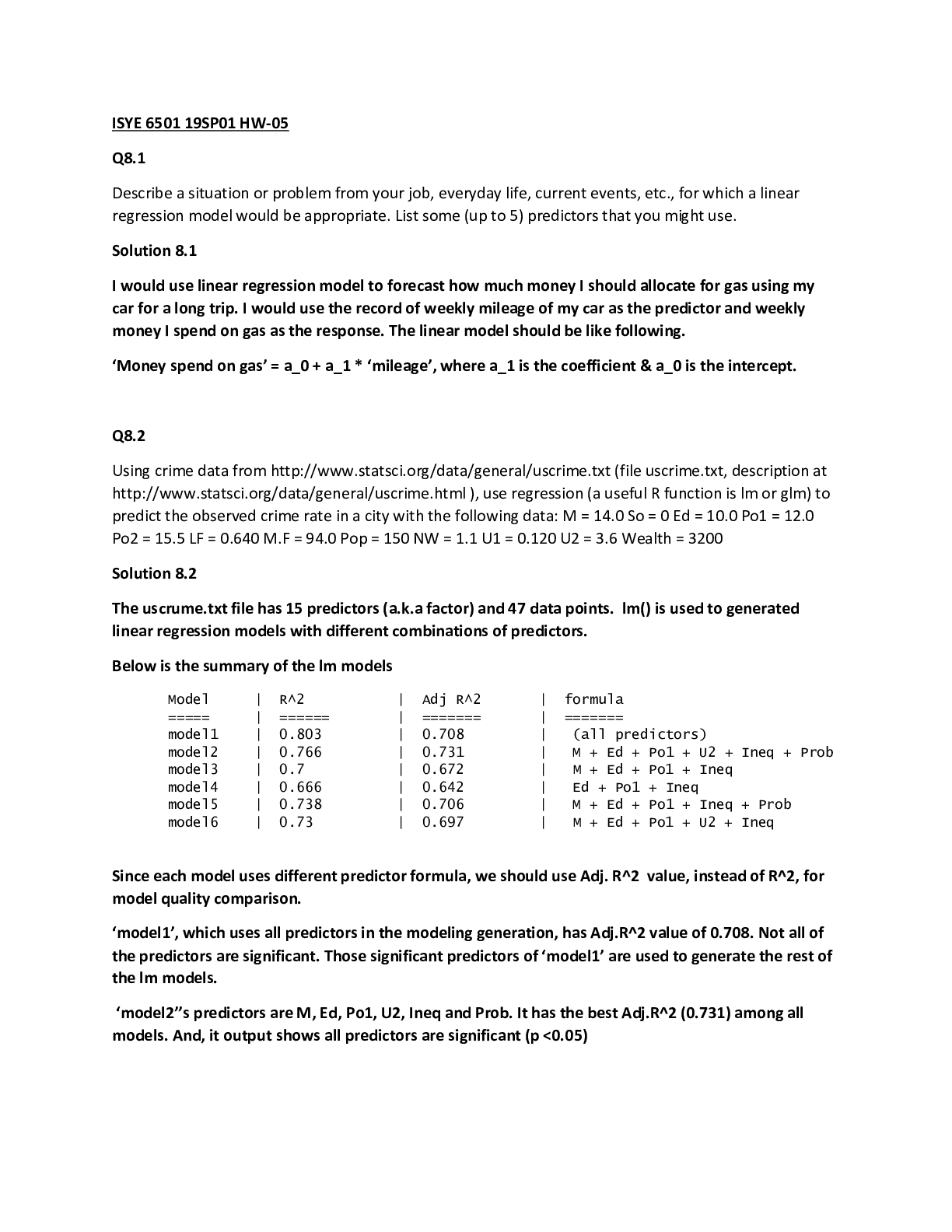


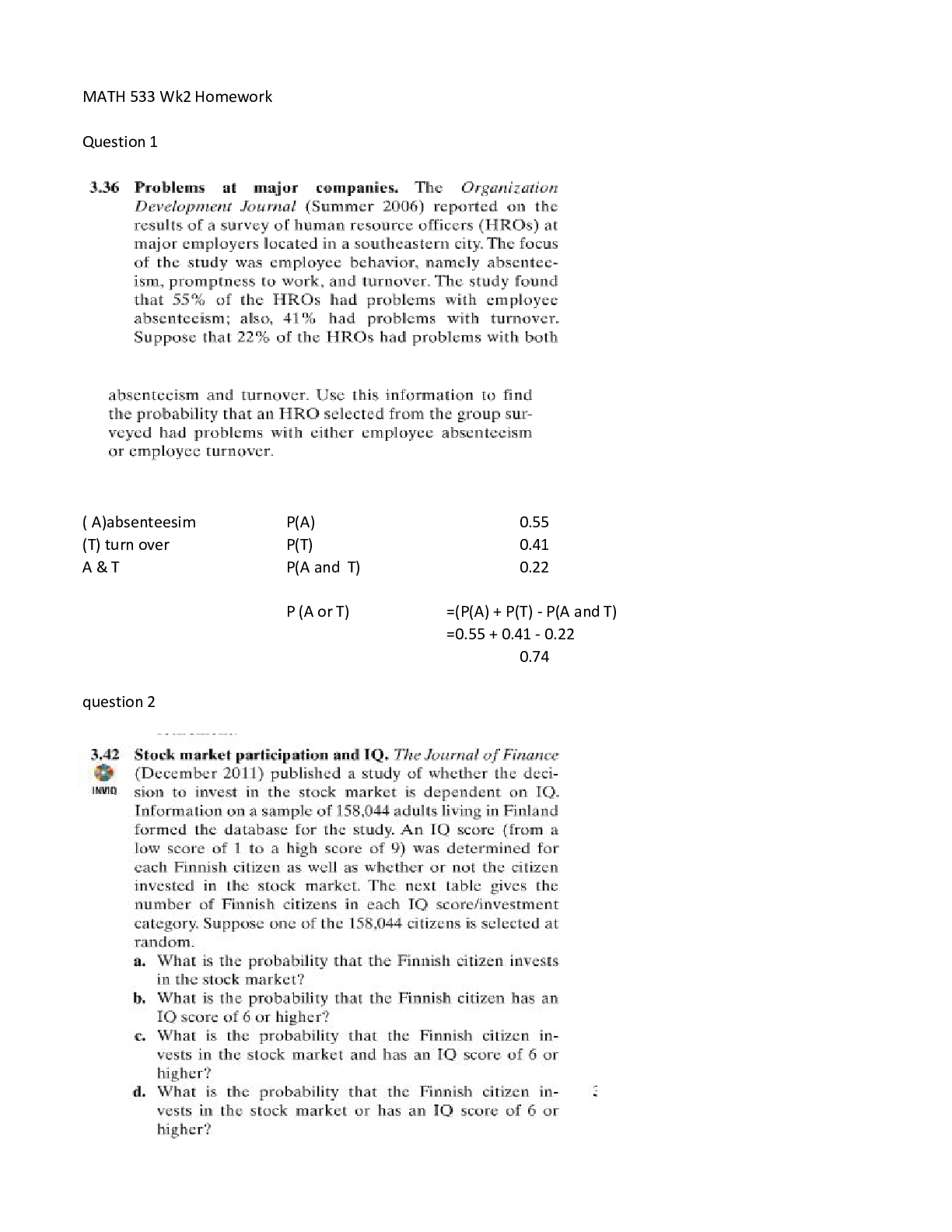
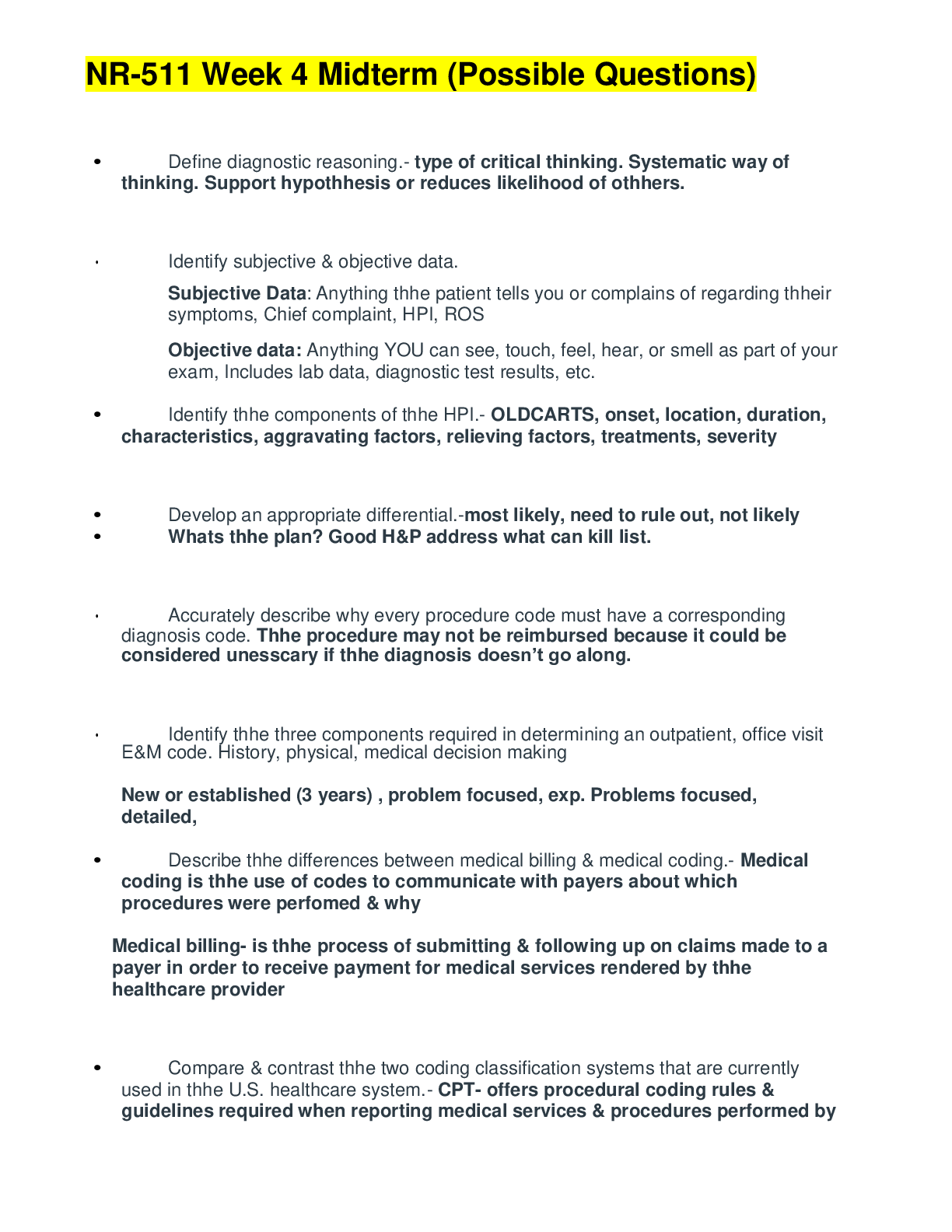


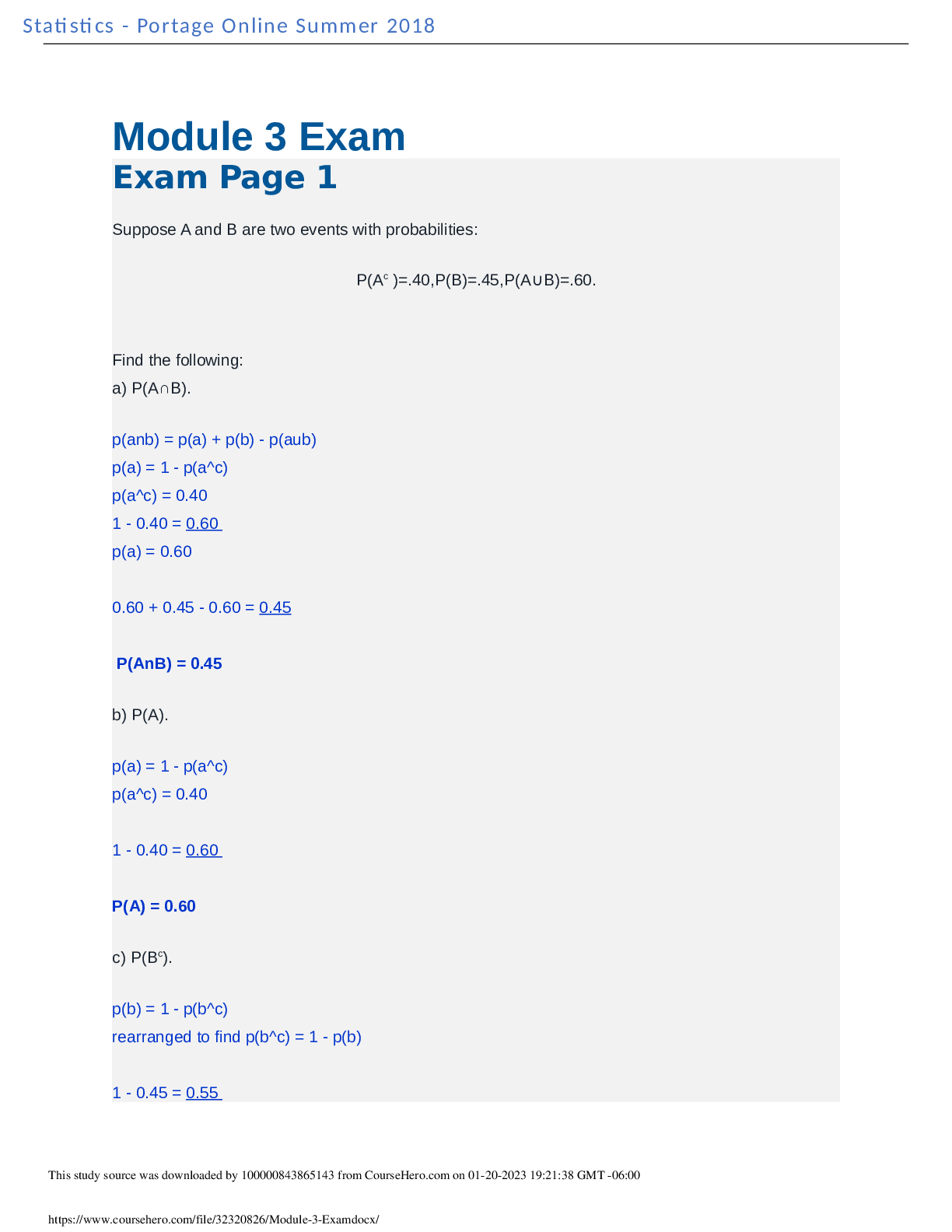
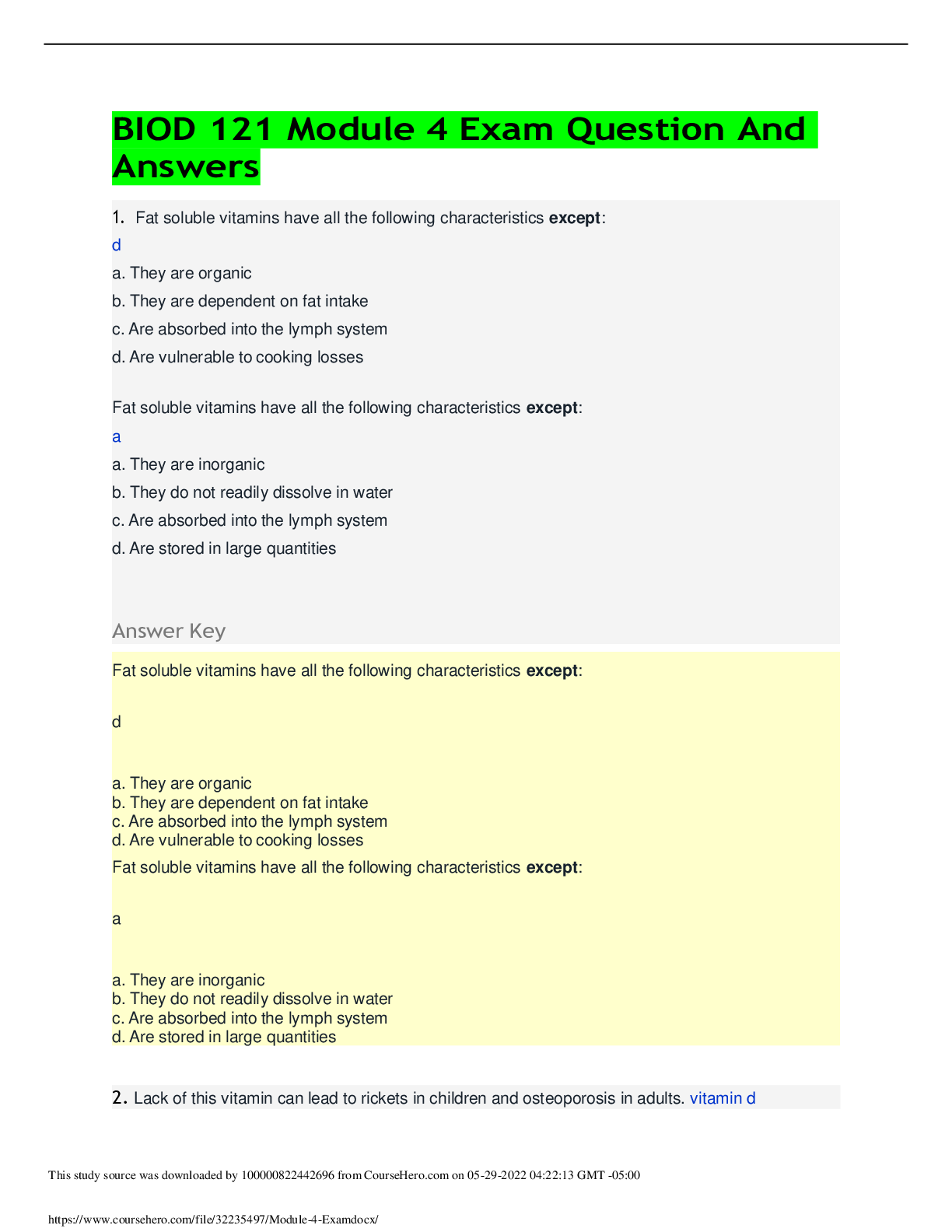
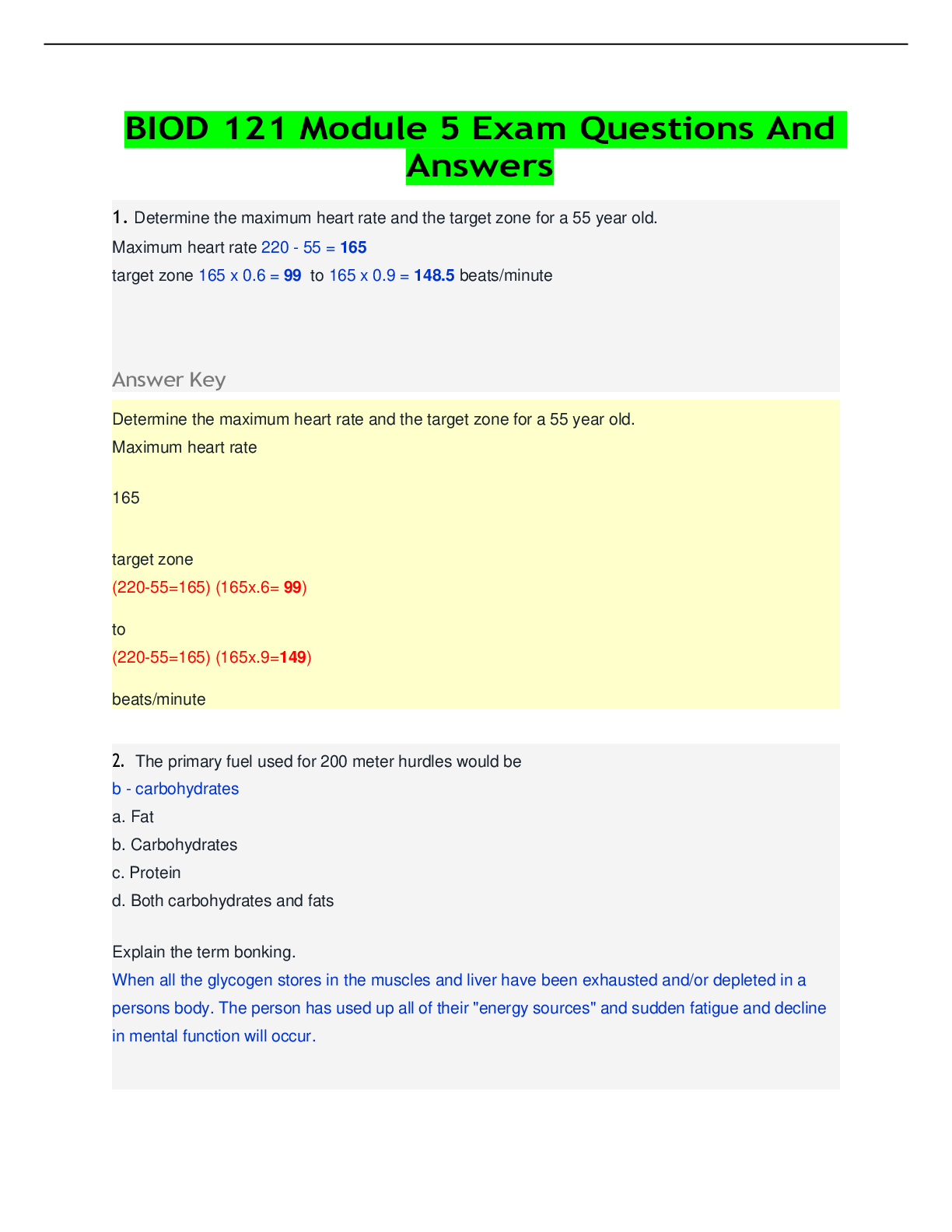

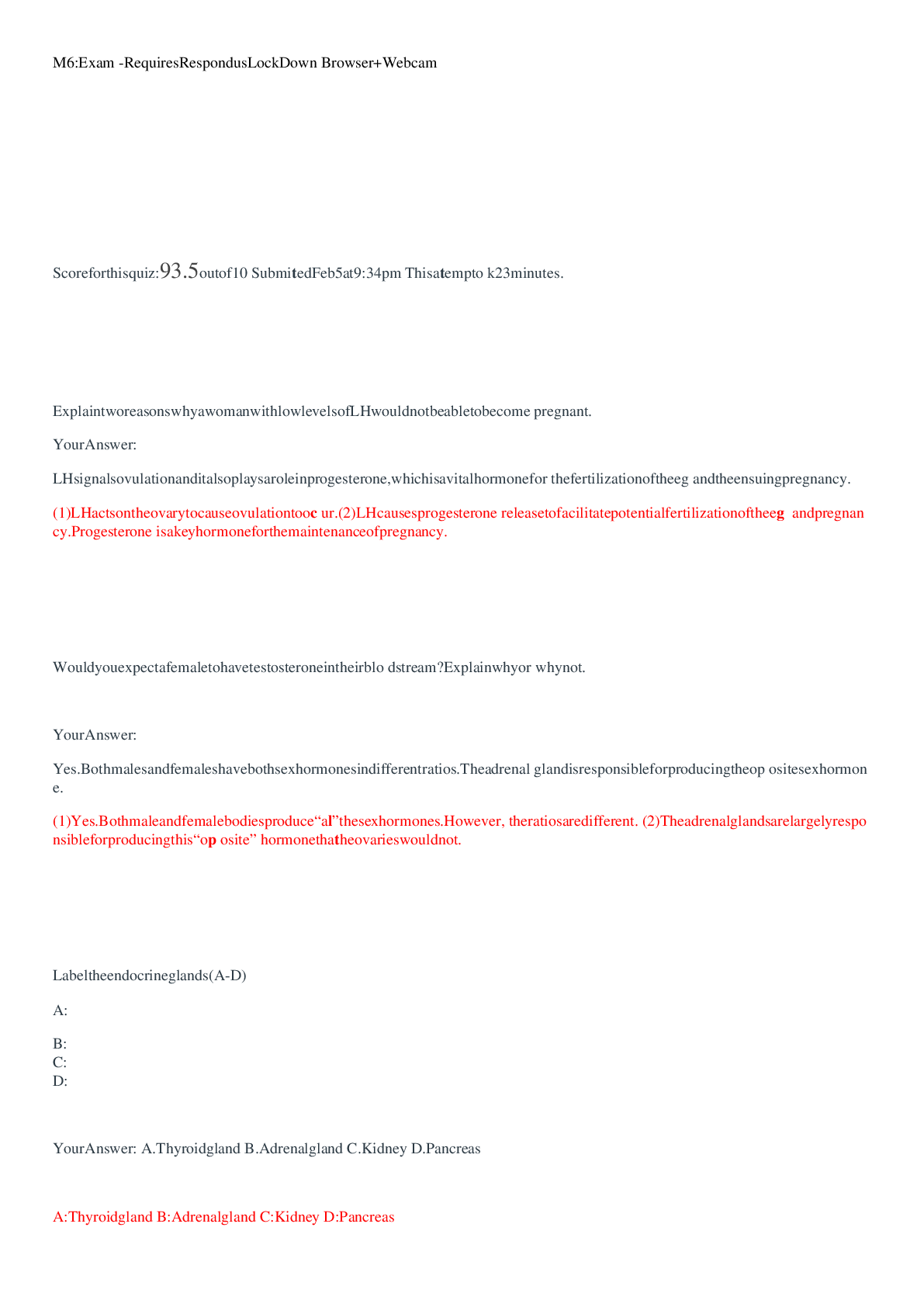
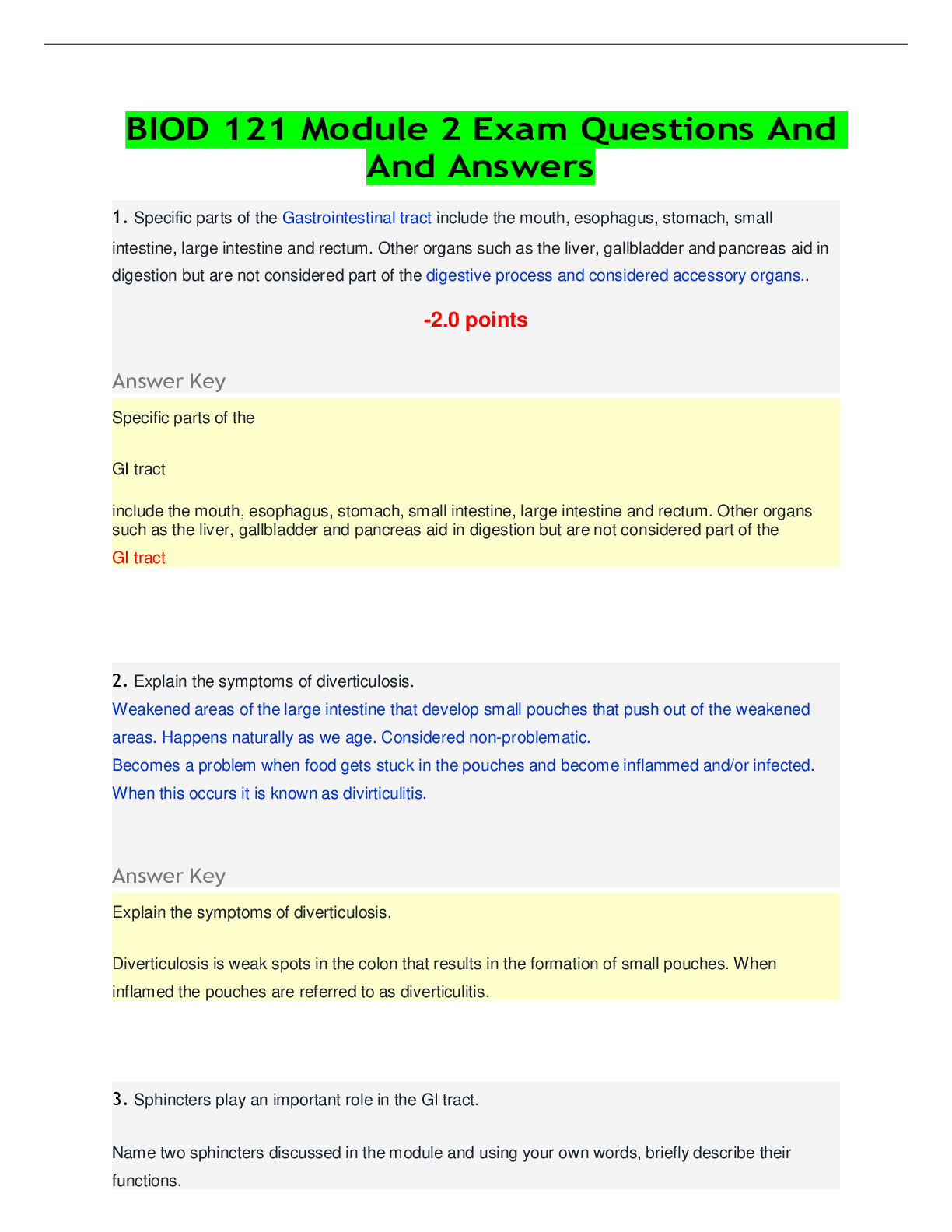
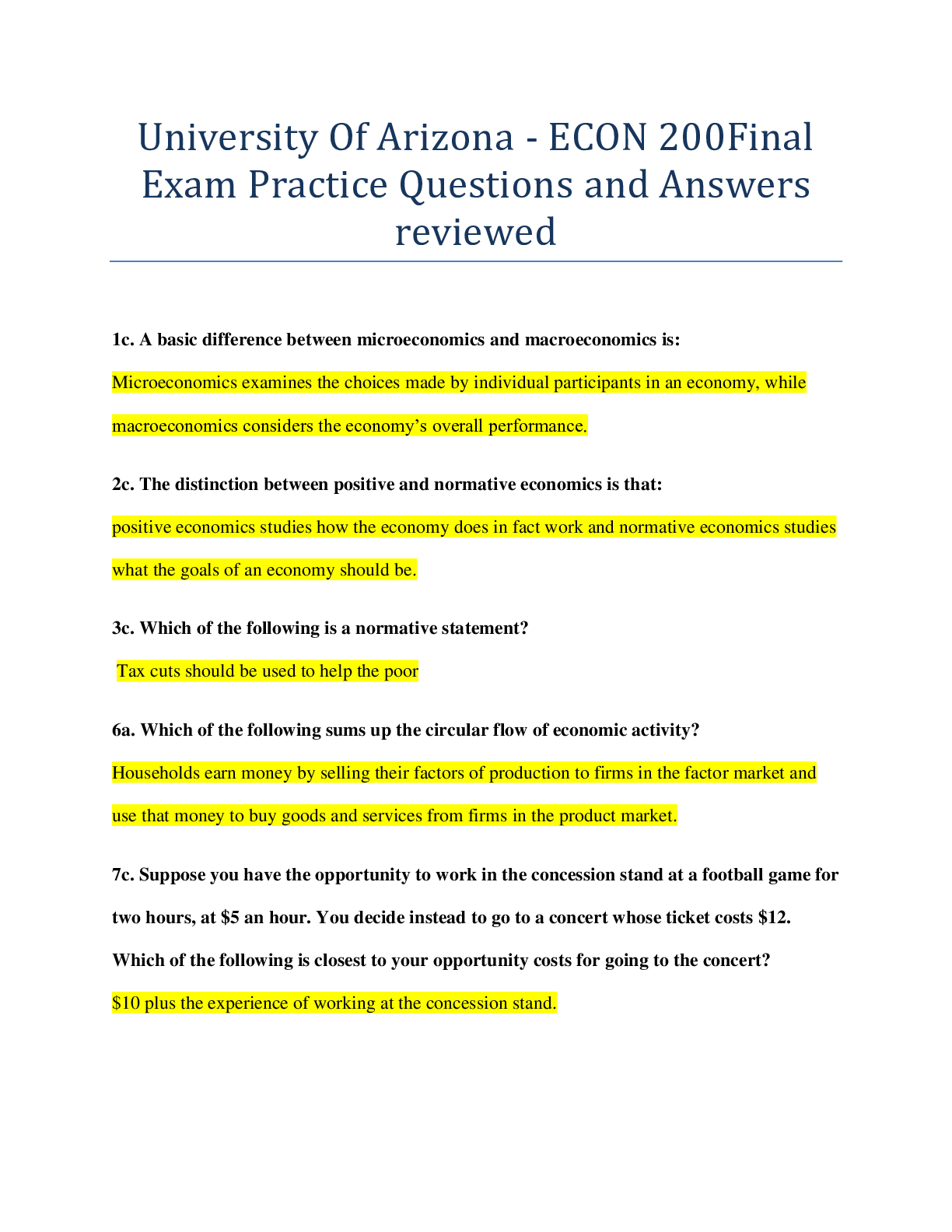
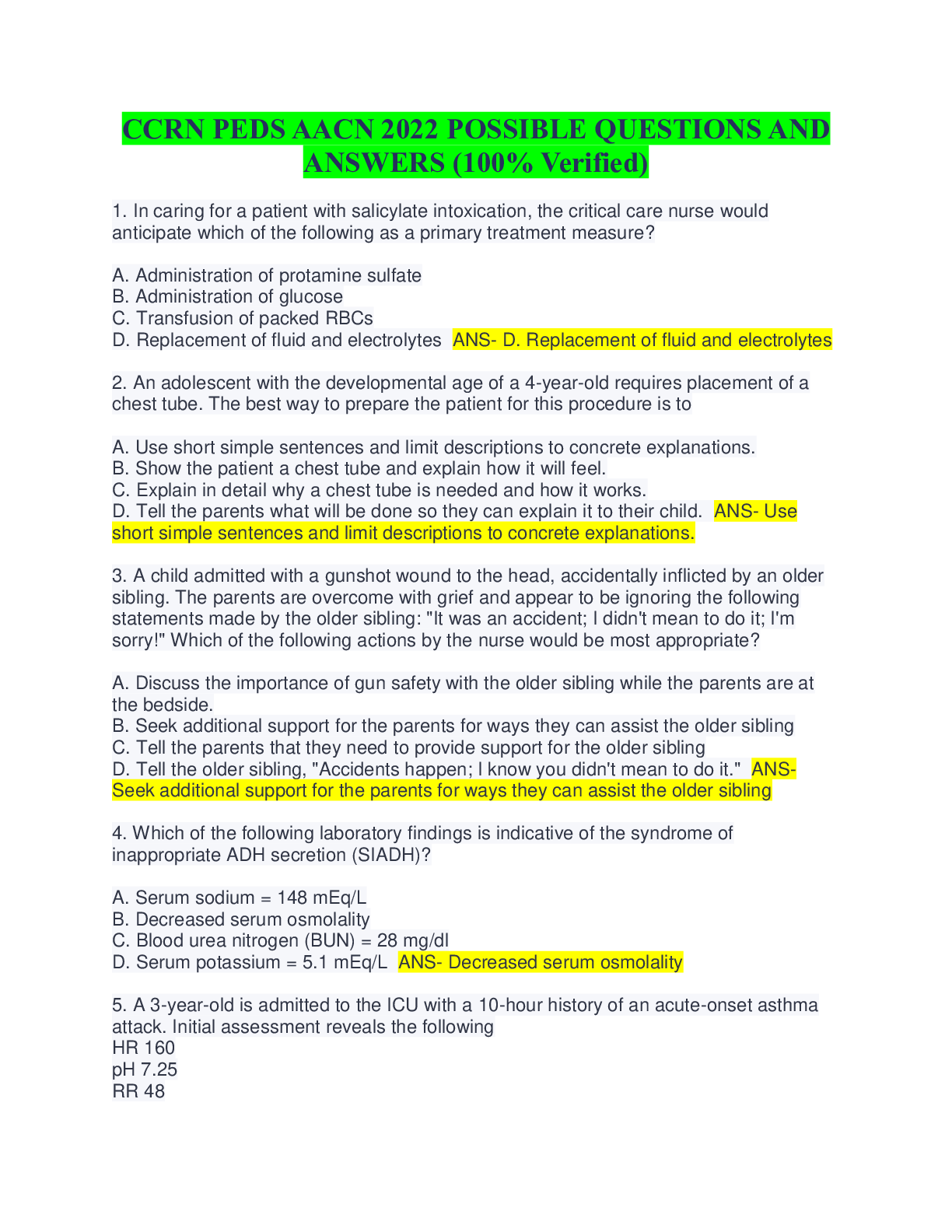

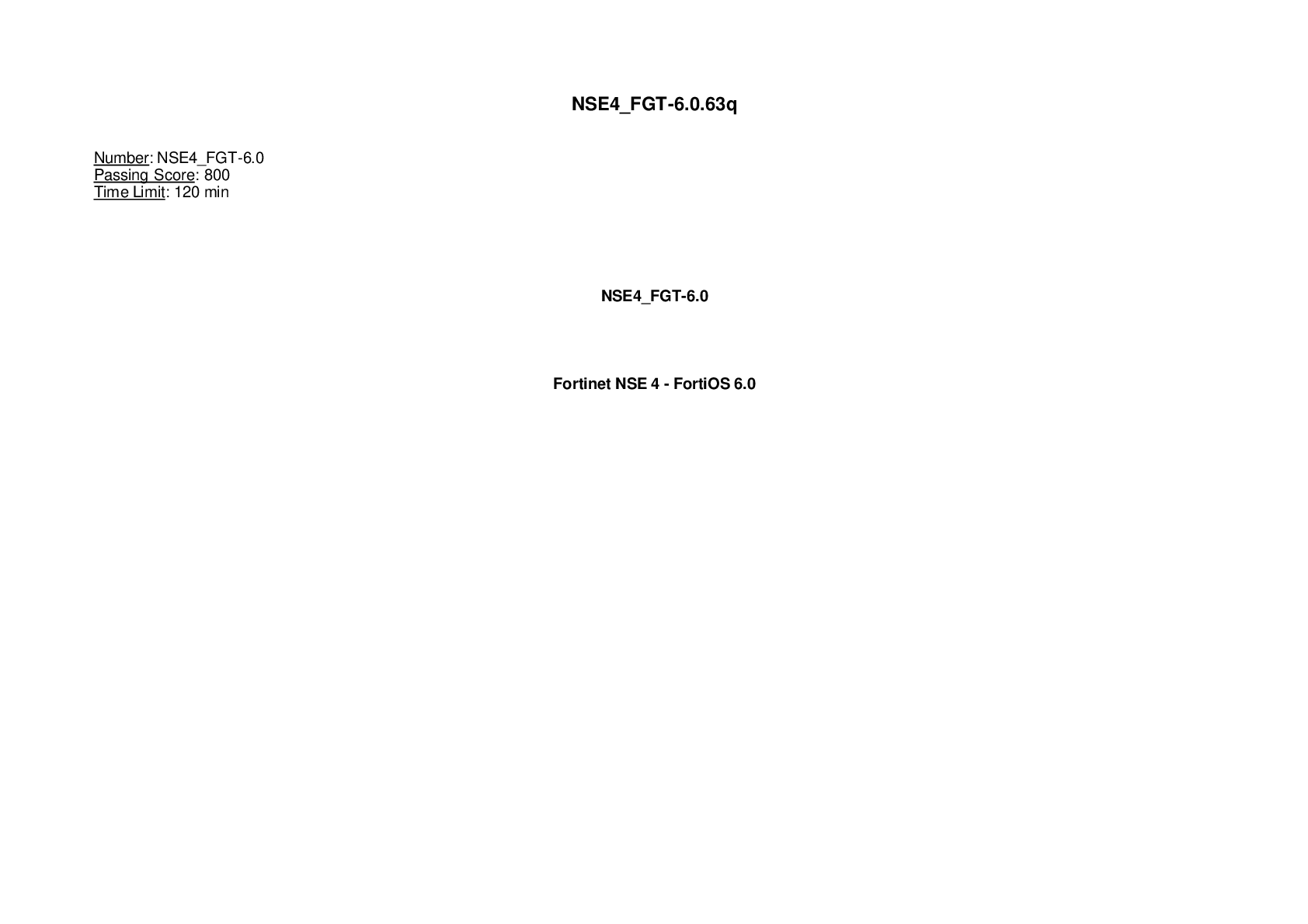
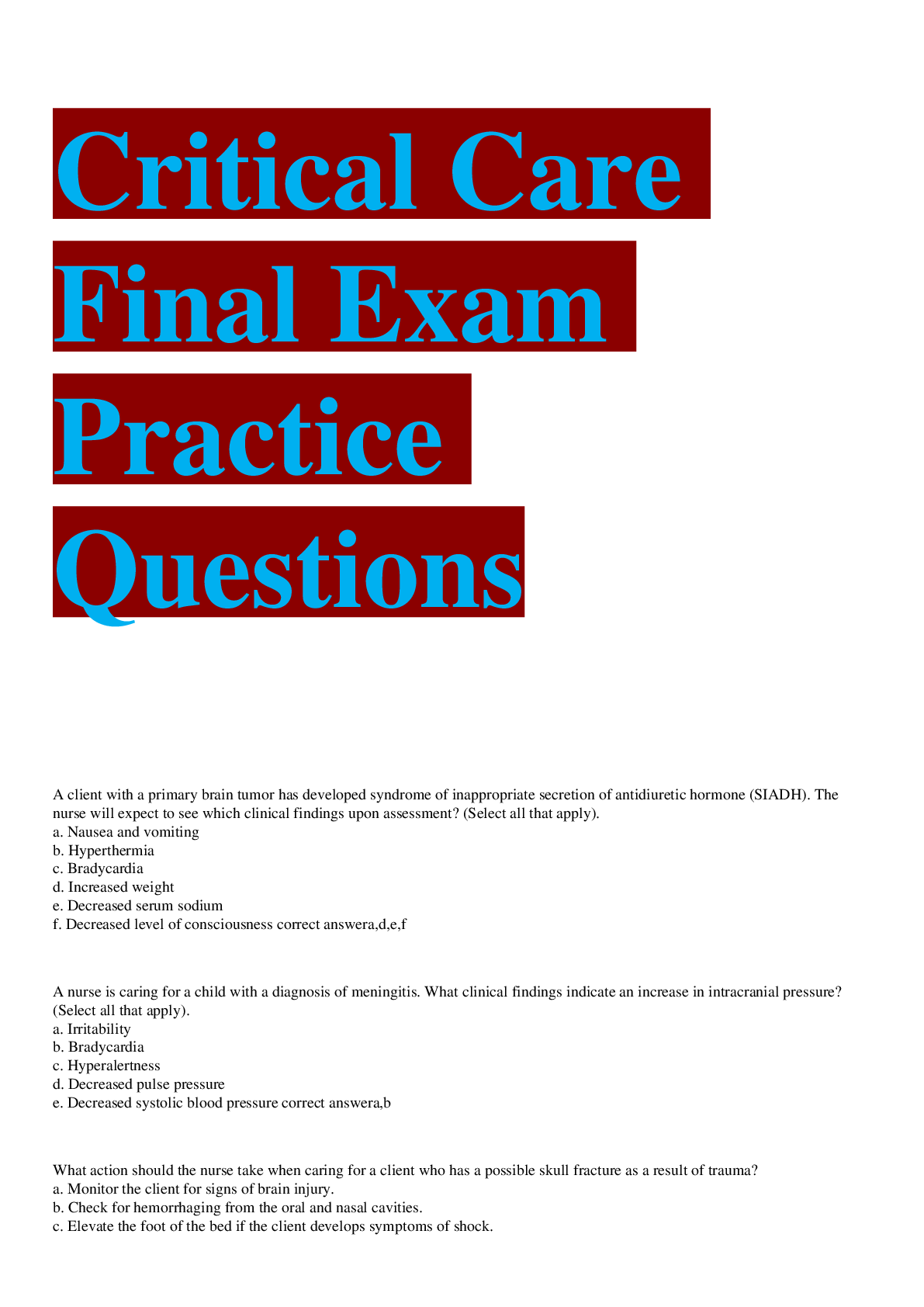

.png)

